Preprint
Article
A Model for Determining the Dependability of Continuous Subsystems in Coal Mines Using the Fuzzy Logic Approach
This version is not peer-reviewed.
Submitted:
24 July 2024
Posted:
24 July 2024
You are already at the latest version
A peer-reviewed article of this preprint also exists.
Abstract
This study presents a unique model for assessing the dependability of continuous parts of combined systems in open-pit mining through the application of fuzzy logic. Continuous sub-systems as part of the combined system of coal exploitation in surface mines have the basic function of ensuring safe operation, high capacity with high reliability and low costs. These subsystems are usually part of the thermal power plant's coal supply system and ensure stable fuel supply. The model integrates various independent partial indicators of dependability into an expert system specifically designed for evaluating these systems. It deconstructs the complex parameter of system dependability into distinct partial indicators: reliability, maintainability, and logistical support. These indicators are then integrated using fuzzy composition (max-min composition). Historical data from 2018 to 2023 is utilized alongside the fuzzy model to provide a retrospective analysis of system dependability, serving to validate the model's effectiveness. What sets this model apart from conventional approaches is its consideration of practical dependability indicators, thereby obviating the need for extensive long-term monitoring and data collection to portray the system's status accurately over time. This model serves as a valuable tool for assisting decision-makers in open-pit mining operations, facilitating planning, exploitation control, and the selection of maintenance strategies to ensure consistent production and cost reduction. Designed for quick assessment, the model relies on expert judgments and assessments to determine system dependability efficiently.
Keywords:
Subject:
Engineering - Mechanical Engineering1. Introduction
Mining operations, crucial to numerous economies worldwide, are undergoing a transformative phase, marked by heightened environmental concerns, technological advancements, and a growing emphasis on operational efficiency [1,2]. These operations include a wide range of activities, from excavation and material extraction to transportation and processing. Within the complex structure of mining activities, transport systems are one of the key components, enabling the smooth movement of materials across large mining sites [3].
Material transportation is a critical aspect of mining operations, significantly influencing costs, efficiency, safety, and environmental impact [4,5]. Considering that loading and transportation costs amount to 60% of the total operating costs, it is essential that these systems are efficient and reliable [6]. The environmental footprint of traditional diesel-powered transport methods necessitates research into sustainable alternatives like electric and autonomous vehicles [7,8]. Moreover, safety and risk management are paramount, with advanced technologies such as automation and real-time monitoring offering new opportunities for optimizing transport routes and enhancing decision-making [9]. Given the complex and variable conditions of mining environments, tailored solutions are essential, making continuous research in this area crucial for achieving greater sustainability, operational excellence, and economic viability in the mining industry.
Various methods and models are used for the purposes of this research in the field of mining, which provide the possibility of dealing with the complex and changing conditions of the mining environment. One of the most widely applied mathematical approaches is the theory of fuzzy sets, which is suitable for the analysis of processes in which uncertainty, ambiguity, subjectivity, and indeterminacy prevail [10].
The application of this method enables the aforementioned problem to be successfully analyzed, and the analysis results reflect the previous expert experiences and results of experimental measurements in a good way. To assess the success of using this method, prior knowledge of the behavior of the analyzed systems and processes is necessary. By comparing the experience and experimental data with the analysis results of the fuzzy logic method, its verification is carried out. Below is an overview of works with the application of fuzzy logic in mining and similar topics.
The largest number of works is related to the field of mechanization in mining, where fuzzy logic was used to evaluate the performance of mining equipment under different operating conditions. The approach takes into account multiple criteria such as reliability, efficiency and maintenance costs [10,11,12,13,14]. This mathematical approach has also found application in various parts of the production process in surface and underground mines, where processes such as loading, transportation, drilling and blasting are adequately optimized [15,16,17,18,19]. The scientific literature also highlights the pervasive nature of risk in mining operations [20,21,22,23,24], emphasizing the need for robust risk management strategies to mitigate the impact of potential failures, where risk assessment methodologies such as failure mode and effects analysis (FMEA) and risk priority number (RPN) calculations are used very effectively in combination with fuzzy logic [25]. Fuzzy logic can also be applied to analyze environmental data collected from mining sites to assess the impact of mining activities on air and water quality, soil stability, and biodiversity. This information can help in developing strategies to minimize environmental degradation and comply with regulatory requirements [26,27,28].
When it comes to transport systems, the evolution of mining practices has witnessed a change that has entailed the adoption of continuous haulage systems, marking a departure from conventional discontinuous methods. While traditional transportation systems that rely on trucks and loaders still predominate in certain contexts, the advent of continuous systems ushered in a new era of efficiency and productivity. Continuous conveyor systems, characterized by crushers, conveyor belts, and integrated automation technologies, offer countless advantages over discontinuous technologies [29].
Given the evolving challenges of environmental sustainability, safety and cost optimization, the role of continuous transport systems is gaining increasing importance in mining operations. These systems, characterized by their ability to operate 24/7 without interruption, offer a path towards sustainable and responsible mining practices. By minimizing energy consumption, reducing carbon emissions and increasing worker safety, continuous transport systems support transformative changes in the mining industry [30].
The continuous part of the combined system is used at the coal open pit Gacko, Republic Srpska. This paper presents a model that predicts the dependability of the continuous part of the combined system (CCS system) at the open pit Gacko applying the fuzzy theory. More precisely, this paper deals with the development of a model for predicting the dependability of the continuous part of the combined system at the open pit using the max-min composition. The basic idea of this paper is an expert assessment of partial indicators that affect the dependability and their synergy in order to determine the dependability of the CCS systems with the help of fuzzy models. In addition to the fuzzy model, a historical overview (period 2018-2023) of data related to the dependability of these systems is given. These historical data served to verify the fuzzy model.
2. Continuous Parts of the Combined System
The CCS system (crusher - belt conveyors - landfill) consists of two semi-mobile primary crushers SB 1315 and SB 1515, belt conveyors TU-3, TU-2, TU-1, and PTU. Coal brought by truck to the SB 1515 crusher is directly shaken onto the same rake, and that brought to the SB 1315 crusher is deposited at the landfill and dosed to the rake using a loader, where after crushing and pulverization by the conveyor system, it is handed over to power plant. Figure 1 shows a view of the open pit Gacko. Figure 2 shows the position of the CCS system at the open pit Gacko.
3. Dependability
Dependability is a common term used to describe the availability and factors affecting it: reliability, maintainability, and level of maintainability [31,32]. The term availability is commonly used as a measure of operational safety [31,33]. The availability is expressed in quantitative indicators, and as such represents a measure of operational safety and thus a measure of quality in use [34]. The performance of availability has a decisive effect on operational safety and quality in use due to the well-known fact that the machine should first of all be available for work, in order to realize the other performances as well [31,34].
Dependability is a complex function that depends on the following performances [35]:
- performances of reliability
- performances of maintainability
- performances of logistic support for maintenance
Operational safety: "A collective term used to describe the availability performance and factors that determine these performances: reliability performances, maintainability performances, and logistics support performances" [35]
4. Materials and Methods
4.1. Development Fuzzy Model
The first step when creating a fuzzy model is the definition of linguistic variables that refer to the partial indicators of dependability, namely:
Reliability represents the probability, at a certain level of confidence, that the system (machine) will successfully perform the function for which it is intended, without failure and within the specified performance limits, taking into account the previous time of system use, during the specified duration of a task. When it is used in the prescribed manner and for the purpose for which it is intended, under the specified load levels. [11]
Maintainability as a set of structural characteristics that affect the time to eliminate failures or the time of performing other maintenance procedures, is an internal property of the observed technical system, therefore it is called structural maintainability. The following parameters affect the maintainability: t - technology, e - tools and equipment, u- unification, d - diagnostics, m - manipulativeness, s - standardization [11,38].
For the technical system to successfully perform the set tasks, it is necessary to provide logistical support and numerous conditions. The logistic support combines the management process with appropriate technical measures to define the necessary support and create conditions for the realization of the given function of the technical system goal.
Logistical support performances according to the ISO-IEC Standard are defined as: "The ability of maintenance system, i.e. the organization that performs maintenance, to provide under given conditions the required maintenance of the technical system in accordance with the maintenance policy [35,36] the Standards of the IEC 300 series deal with the concept of logistic support for maintenance [37].
Figure 5.
Presentation of partial indicators of dependability.
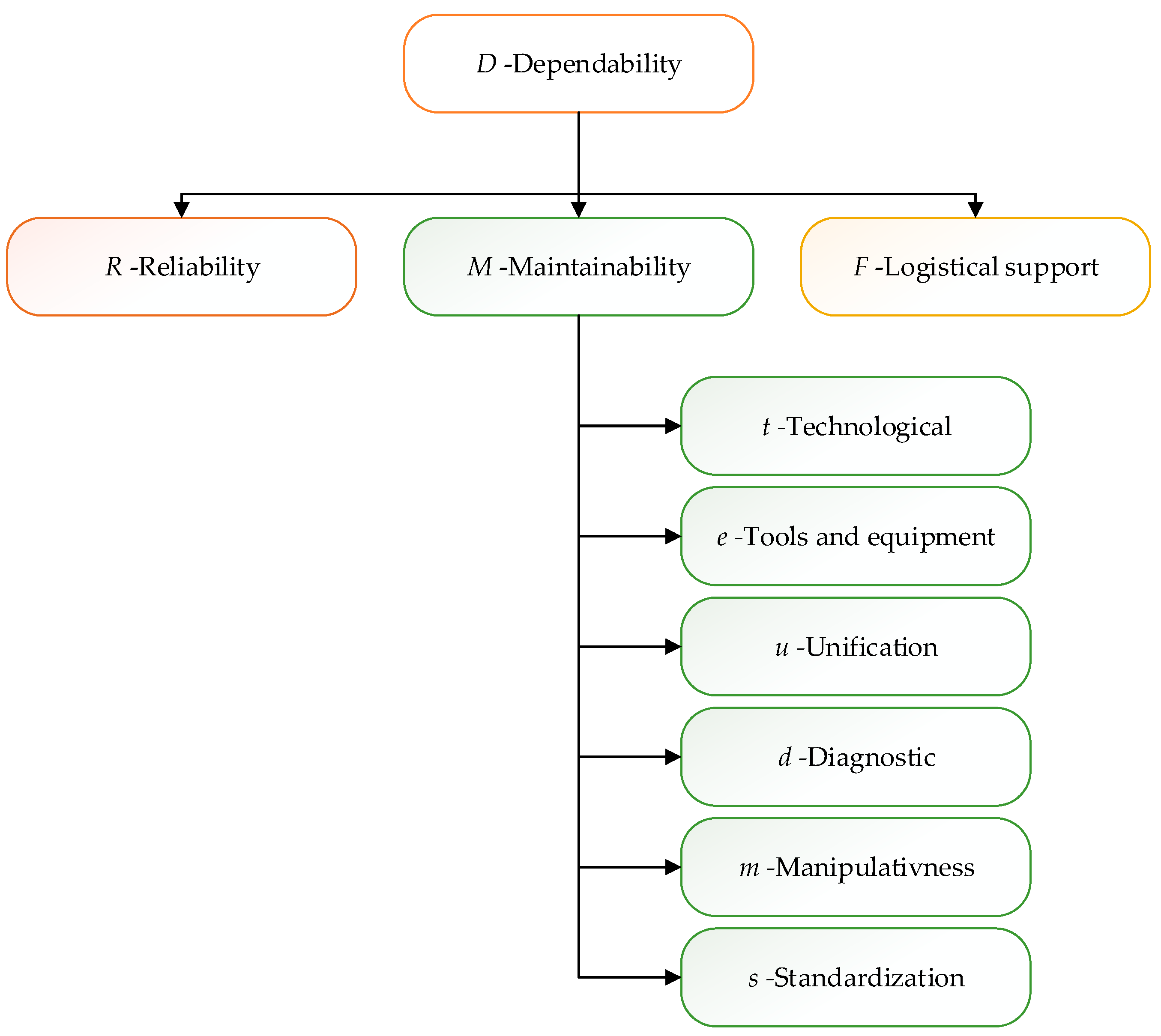
In terms of the number of linguistic variables, it can be inferred that seven is the maximum count of variables that a person can rationally recognize simultaneously while retaining the same meaning [39].
Taking this statement into account, the five ratings (linguistic variables), defined as follows: excellent (exc), good (good), average (aver), adequate (adeq), and poor (poor), will be considered in this paper. Linguistic variables (ratings) are given in the form of triangular fuzzy numbers, and their graphic representation is presented in the following figure.
Corresponding fuzzy numbers of the mentioned linguistic variables are defined by (according to Figure 6):
Partial indicators t, e, u, d, m, s more closely determines the partial indicator M- maintenance convenience, while M – maintainability together with R-reliability and F- logistic support determine the D- dependability of the system. It will be shown in the following how the dependability D is determined based on indicators of maintainability M, reliability R and logistical support F, while the maintenance convenience M is obtained similarly based on partial indicators t, e, u, d, m, s.
The idea of this work is to obtain a more accurate assessment of the dependability of CCS systems at the open pit Gacko. This assessment was identified as the best possible among the worst expected ratings of the partial availability indicators (R, M , and F). Let the partial indicators R, M, F be shown in the form of the following triangular fuzzy numbers
In the next step, the max-min composition is performed on them. If the mentioned partial indicators R, M, F are observed, it is possible to make combinations of corresponding membership functions, which will be further denoted with
Each of these combinations represents one possible assessment of the dependability and the following two values can be associate with it
and
takes values from the set , and each of the mentioned values can be associated with the number which represents the maximum value of is equal to , za , that is
In this way, a rating for the dependability of is obtained
Using the best-fit method, see [11], to transform the obtained ratings into belonging to the fuzzy set, determined by (2), the distance is used that is defined by
For . Small values indicate proximity to the linguistic variable . Accordingly, let be the minimum value of the obtained distances , then the reciprocal value of the relative distances can be associated to each of them that is determined by:
If for some i the distance value is equal to 0, then the corresponding value of the reciprocal value of relative distance is while the other values of the reciprocal relative distances are equal to 0. The normalized values of thus obtained reciprocal values of the relative distances are determined by:
and present belonging to the appropriate rating:
In the end, the appropriate linguistic rating is obtained as follows:
In a similar way, a rating for maintainability M is obtained from the linguistic variables t, e, u, d, m, s which is later used to determine the dependability D.
Figure 7 shows the fuzzy model algorithm for dependability evaluation.
4.2. Case Study – Open Pit Gacko
4.2.1. Results of Expert Evaluation
Determination of the dependability of the system and its partial indicators was processed through the results obtained through questionnaires related to the expert evaluation of the partial indicators of operational safety. The questionnaire contained detailed descriptions of the partial indicators themselves. In the expert evaluation, 10 experts were surveyed. The first 5 experts are representatives of the Gacko Mine (experts from this field with many years of work on these systems - minimum 10 years of work experience), and the other 5 experts are external experts with many years of experience in the field of open pit mining. Ratings are expressed using membership functions representing predefined linguistic variables ranging from 'poor' to 'excellent' within a scale of 0 to 1. Additionally, a parameter can be associated with multiple linguistic variables simultaneously, ensuring that the total sum of ratings equals 1. The following tables give the results of expert evaluation for each part of the CCS system. The layout of one questionnaire is given in Figure 8.
Table 1.
Results of expert evaluation for Crusher SB 1515.
| Expert | Type | poor | adeq | aver | good | exc | Expert | Type | poor | adeq | aver | good | exc |
| 1 | R | 0 | 0.5 | 0.5 | 0 | 0 | 6 | R | 0 | 0 | 0 | 0.6 | 0.4 |
| t | 0 | 0.2 | 0.8 | 0 | 0 | t | 0 | 0.4 | 0.6 | 0 | 0 | ||
| e | 0 | 0.6 | 0.4 | 0 | 0 | e | 0 | 0.2 | 0.8 | 0 | 0 | ||
| u | 0.2 | 0.8 | 0 | 0 | 0 | u | 0 | 0.1 | 0.9 | 0 | 0 | ||
| d | 0 | 0.5 | 0.5 | 0 | 0 | d | 0 | 0.4 | 0.6 | 0 | 0 | ||
| m | 0 | 0.3 | 0.7 | 0 | 0 | m | 0 | 0.3 | 0.7 | 0 | 0 | ||
| s | 0 | 0.1 | 0.9 | 0 | 0 | s | 0 | 0.7 | 0.3 | 0 | 0 | ||
| F | 0.4 | 0.6 | 0 | 0 | 0 | F | 0.2 | 0.8 | 0 | 0 | 0 | ||
| 2 | R | 0 | 0 | 0.3 | 0.7 | 0 | 7 | R | 0 | 0 | 0.3 | 0.7 | 0 |
| t | 0 | 0 | 0.35 | 0.65 | 0 | t | 0 | 0 | 0.2 | 0.8 | 0 | ||
| e | 0 | 0 | 0.2 | 0.8 | 0 | e | 0 | 0 | 0 | 0.4 | 0.6 | ||
| u | 0 | 0 | 0.6 | 0.4 | 0 | u | 0 | 0.4 | 0.6 | 0 | 0 | ||
| d | 0.2 | 0.8 | 0 | 0 | 0 | d | 0 | 0 | 0 | 0.6 | 0.4 | ||
| m | 0.5 | 0.5 | 0 | 0 | 0 | m | 0 | 0 | 0.2 | 0.8 | 0 | ||
| s | 0 | 0.7 | 0.3 | 0 | 0 | s | 0 | 0 | 0.3 | 0.7 | 0 | ||
| F | 0 | 0.3 | 0.7 | 0 | 0 | F | 0 | 0.4 | 0.6 | 0 | 0 | ||
| 3 | R | 0 | 0 | 0.3 | 0.7 | 0 | 8 | R | 0 | 0 | 0 | 0.8 | 0.2 |
| t | 0 | 0 | 0.4 | 0.6 | 0 | t | 0 | 0.4 | 0.6 | 0 | 0 | ||
| e | 0 | 0 | 0.45 | 0.55 | 0 | e | 0 | 0.3 | 0.7 | 0 | 0 | ||
| u | 0 | 0.25 | 0.75 | 0 | 0 | u | 0 | 0.6 | 0.4 | 0 | 0 | ||
| d | 0 | 0.1 | 0.9 | 0 | 0 | d | 0 | 0 | 0.2 | 0.8 | 0 | ||
| m | 0.4 | 0.6 | 0 | 0 | 0 | m | 0 | 0 | 0.7 | 0.3 | 0 | ||
| s | 0 | 0.6 | 0.4 | 0 | 0 | s | 0 | 0.4 | 0.6 | 0 | 0 | ||
| F | 0 | 0.3 | 0.7 | 0 | 0 | F | 0 | 0.1 | 0.9 | 0 | 0 | ||
| 4 | R | 0 | 0 | 0.1 | 0.9 | 0 | 9 | R | 0 | 0 | 0 | 0.9 | 0.1 |
| t | 0 | 0 | 0.2 | 0.8 | 0 | t | 0 | 0.3 | 0.7 | 0 | 0 | ||
| e | 0 | 0.5 | 0.5 | 0 | 0 | e | 0 | 0 | 0.2 | 0.8 | 0 | ||
| u | 0.4 | 0.6 | 0 | 0 | 0 | u | 0 | 0 | 0.4 | 0.6 | 0 | ||
| d | 0 | 0.4 | 0.6 | 0 | 0 | d | 0 | 0 | 0.2 | 0.8 | 0 | ||
| m | 0.3 | 0.7 | 0 | 0 | 0 | m | 0 | 0 | 0.7 | 0.3 | 0 | ||
| s | 0.25 | 0.75 | 0 | 0 | 0 | s | 0 | 0.3 | 0.7 | 0 | 0 | ||
| F | 0.15 | 0.85 | 0 | 0 | 0 | F | 0.2 | 0.8 | 0 | 0 | 0 | ||
| 5 | R | 0 | 0 | 0.3 | 0.7 | 0 | 10 | R | 0 | 0 | 0.6 | 0.4 | 0 |
| t | 0 | 0.3 | 0.7 | 0 | 0 | t | 0 | 0.3 | 0.7 | 0 | 0 | ||
| e | 0 | 0.7 | 0.3 | 0 | 0 | e | 0 | 0.4 | 0.6 | 0 | 0 | ||
| u | 0 | 0.4 | 0.6 | 0 | 0 | u | 0 | 0.6 | 0.4 | 0 | 0 | ||
| d | 0.3 | 0.7 | 0 | 0 | 0 | d | 0 | 0.1 | 0.9 | 0 | 0 | ||
| m | 0 | 0.6 | 0.4 | 0 | 0 | m | 0 | 0.7 | 0.3 | 0 | 0 | ||
| s | 0.3 | 0.7 | 0 | 0 | 0 | s | 0 | 0.2 | 0.8 | 0 | 0 | ||
| F | 0 | 0.3 | 0.7 | 0 | 0 | F | 0 | 0.4 | 0.6 | 0 | 0 |
Table 2.
Results of expert evaluation for Crusher SB 1315.
| Expert | Type | poor | adeq | aver | good | exc | Expert | Type | poor | adeq | aver | good | exc |
| 1 | R | 0 | 0 | 0 | 0.6 | 0.4 | 6 | R | 0 | 0 | 0 | 0.6 | 0.4 |
| t | 0 | 0 | 0.2 | 0.8 | 0 | t | 0 | 0.4 | 0.6 | 0 | 0 | ||
| e | 0 | 0 | 0 | 0.7 | 0.3 | e | 0 | 0.2 | 0.8 | 0 | 0 | ||
| u | 0.45 | 0.55 | 0 | 0 | 0 | u | 0 | 0.1 | 0.9 | 0 | 0 | ||
| d | 0 | 0 | 0.1 | 0.9 | 0 | d | 0 | 0.4 | 0.6 | 0 | 0 | ||
| m | 0 | 0.3 | 0.7 | 0 | 0 | m | 0 | 0.3 | 0.7 | 0 | 0 | ||
| s | 0 | 0.2 | 0.8 | 0 | 0 | s | 0 | 0.7 | 0.3 | 0 | 0 | ||
| F | 0 | 0 | 0.4 | 0.6 | 0 | F | 0.2 | 0.8 | 0 | 0 | 0 | ||
| 2 | R | 0 | 0 | 0.3 | 0.7 | 0 | 7 | R | 0 | 0 | 0.3 | 0.7 | 0 |
| t | 0 | 0 | 0 | 0.3 | 0.7 | t | 0 | 0 | 0.2 | 0.8 | 0 | ||
| e | 0 | 0 | 0 | 0.4 | 0.6 | e | 0 | 0 | 0 | 0.4 | 0.6 | ||
| u | 0 | 0 | 0.2 | 0.8 | 0 | u | 0 | 0.4 | 0.6 | 0 | 0 | ||
| d | 0 | 0 | 0.4 | 0.6 | 0 | d | 0 | 0 | 0 | 0.6 | 0.4 | ||
| m | 0.5 | 0.5 | 0 | 0 | 0 | m | 0 | 0 | 0.2 | 0.8 | 0 | ||
| s | 0 | 0 | 0.8 | 0.2 | 0 | s | 0 | 0 | 0.3 | 0.7 | 0 | ||
| F | 0 | 0 | 0.2 | 0.8 | 0 | F | 0 | 0.4 | 0.6 | 0 | 0 | ||
| 3 | R | 0 | 0 | 0.3 | 0.7 | 0 | 8 | R | 0 | 0 | 0 | 0.8 | 0.2 |
| t | 0 | 0 | 0.4 | 0.6 | 0 | t | 0 | 0.4 | 0.6 | 0 | 0 | ||
| e | 0 | 0 | 0.45 | 0.55 | 0 | e | 0 | 0.3 | 0.7 | 0 | 0 | ||
| u | 0 | 0.25 | 0.75 | 0 | 0 | u | 0 | 0.6 | 0.4 | 0 | 0 | ||
| d | 0 | 0.1 | 0.9 | 0 | 0 | d | 0 | 0 | 0.2 | 0.8 | 0 | ||
| m | 0.4 | 0.6 | 0 | 0 | 0 | m | 0 | 0 | 0.7 | 0.3 | 0 | ||
| s | 0 | 0.6 | 0.4 | 0 | 0 | s | 0 | 0.4 | 0.6 | 0 | 0 | ||
| F | 0 | 0.3 | 0.7 | 0 | 0 | F | 0 | 0.1 | 0.9 | 0 | 0 | ||
| 4 | R | 0 | 0 | 0.1 | 0.9 | 0 | 9 | R | 0 | 0 | 0 | 0.9 | 0.1 |
| t | 0 | 0 | 0.2 | 0.8 | 0 | t | 0 | 0.3 | 0.7 | 0 | 0 | ||
| e | 0 | 0.5 | 0.5 | 0 | 0 | e | 0 | 0 | 0.2 | 0.8 | 0 | ||
| u | 0.4 | 0.6 | 0 | 0 | 0 | u | 0 | 0 | 0.4 | 0.6 | 0 | ||
| d | 0 | 0.4 | 0.6 | 0 | 0 | d | 0 | 0 | 0.7 | 0.3 | 0 | ||
| m | 0.3 | 0.7 | 0 | 0 | 0 | m | 0 | 0 | 0.4 | 0.6 | 0 | ||
| s | 0.25 | 0.75 | 0 | 0 | 0 | s | 0 | 0.3 | 0.7 | 0 | 0 | ||
| F | 0.15 | 0.85 | 0 | 0 | 0 | F | 0.2 | 0.8 | 0 | 0 | 0 | ||
| 5 | R | 0 | 0 | 0.3 | 0.7 | 0 | 10 | R | 0 | 0 | 0.6 | 0.4 | 0 |
| t | 0 | 0.3 | 0.7 | 0 | 0 | t | 0 | 0.3 | 0.7 | 0 | 0 | ||
| e | 0 | 0.7 | 0.3 | 0 | 0 | e | 0 | 0.4 | 0.6 | 0 | 0 | ||
| u | 0 | 0.4 | 0.6 | 0 | 0 | u | 0 | 0.6 | 0.4 | 0 | 0 | ||
| d | 0.3 | 0.7 | 0 | 0 | 0 | d | 0 | 0.1 | 0.9 | 0 | 0 | ||
| m | 0 | 0.6 | 0.4 | 0 | 0 | m | 0 | 0.7 | 0.3 | 0 | 0 | ||
| s | 0.3 | 0.7 | 0 | 0 | 0 | s | 0 | 0.2 | 0.8 | 0 | 0 | ||
| F | 0 | 0.3 | 0.7 | 0 | 0 | F | 0 | 0.4 | 0.6 | 0 | 0 |
Table 3.
Results of expert evaluation for belt conveyors.
| Expert | Type | poor | adeq | aver | good | exc | Expert | Type | poor | adeq | aver | good | exc |
| 1 | R | 0 | 0.5 | 0.5 | 0 | 0 | 6 | R | 0 | 0 | 0 | 0.6 | 0.4 |
| t | 0 | 0.2 | 0.8 | 0 | 0 | t | 0 | 0.4 | 0.6 | 0 | 0 | ||
| e | 0 | 0.6 | 0.4 | 0 | 0 | e | 0 | 0.2 | 0.8 | 0 | 0 | ||
| u | 0.2 | 0.8 | 0 | 0 | 0 | u | 0 | 0.1 | 0.9 | 0 | 0 | ||
| d | 0 | 0.5 | 0.5 | 0 | 0 | d | 0 | 0.4 | 0.6 | 0 | 0 | ||
| m | 0 | 0.3 | 0.7 | 0 | 0 | m | 0 | 0.3 | 0.7 | 0 | 0 | ||
| s | 0 | 0.1 | 0.9 | 0 | 0 | s | 0 | 0.7 | 0.3 | 0 | 0 | ||
| F | 0.4 | 0.6 | 0 | 0 | 0 | F | 0.2 | 0.8 | 0 | 0 | 0 | ||
| 2 | R | 0 | 0 | 0.3 | 0.7 | 0 | 7 | R | 0 | 0 | 0.3 | 0.7 | 0 |
| t | 0 | 0 | 0.35 | 0.65 | 0 | t | 0 | 0 | 0.2 | 0.8 | 0 | ||
| e | 0 | 0 | 0.2 | 0.8 | 0 | e | 0 | 0 | 0 | 0.4 | 0.6 | ||
| u | 0 | 0 | 0.6 | 0.4 | 0 | u | 0 | 0.4 | 0.6 | 0 | 0 | ||
| d | 0.2 | 0.8 | 0 | 0 | 0 | d | 0 | 0 | 0 | 0.6 | 0.4 | ||
| m | 0.5 | 0.5 | 0 | 0 | 0 | m | 0 | 0 | 0.2 | 0.8 | 0 | ||
| s | 0 | 0.7 | 0.3 | 0 | 0 | s | 0 | 0 | 0.3 | 0.7 | 0 | ||
| F | 0 | 0.3 | 0.7 | 0 | 0 | F | 0 | 0.4 | 0.6 | 0 | 0 | ||
| 3 | R | 0 | 0 | 0.3 | 0.7 | 0 | 8 | R | 0 | 0 | 0 | 0.8 | 0.2 |
| t | 0 | 0 | 0.4 | 0.6 | 0 | t | 0 | 0.4 | 0.6 | 0 | 0 | ||
| e | 0 | 0 | 0.45 | 0.55 | 0 | e | 0 | 0.3 | 0.7 | 0 | 0 | ||
| u | 0 | 0.25 | 0.75 | 0 | 0 | u | 0 | 0.6 | 0.4 | 0 | 0 | ||
| d | 0 | 0.1 | 0.9 | 0 | 0 | d | 0 | 0 | 0.2 | 0.8 | 0 | ||
| m | 0.4 | 0.6 | 0 | 0 | 0 | m | 0 | 0 | 0.7 | 0.3 | 0 | ||
| s | 0 | 0.6 | 0.4 | 0 | 0 | s | 0 | 0.4 | 0.6 | 0 | 0 | ||
| F | 0 | 0.3 | 0.7 | 0 | 0 | F | 0 | 0.1 | 0.9 | 0 | 0 | ||
| 4 | R | 0 | 0 | 0.1 | 0.9 | 0 | 9 | R | 0 | 0 | 0 | 0.9 | 0.1 |
| t | 0 | 0 | 0.2 | 0.8 | 0 | t | 0 | 0.3 | 0.7 | 0 | 0 | ||
| e | 0 | 0.5 | 0.5 | 0 | 0 | e | 0 | 0 | 0.2 | 0.8 | 0 | ||
| u | 0.4 | 0.6 | 0 | 0 | 0 | u | 0 | 0 | 0.4 | 0.6 | 0 | ||
| d | 0 | 0.4 | 0.6 | 0 | 0 | d | 0 | 0 | 0.7 | 0.3 | 0 | ||
| m | 0.3 | 0.7 | 0 | 0 | 0 | m | 0 | 0 | 0.4 | 0.6 | 0 | ||
| s | 0.25 | 0.75 | 0 | 0 | 0 | s | 0 | 0.3 | 0.7 | 0 | 0 | ||
| F | 0.15 | 0.85 | 0 | 0 | 0 | F | 0.2 | 0.8 | 0 | 0 | 0 | ||
| 5 | R | 0 | 0 | 0.3 | 0.7 | 0 | 10 | R | 0 | 0 | 0.6 | 0.4 | 0 |
| t | 0 | 0.3 | 0.7 | 0 | 0 | t | 0 | 0.3 | 0.7 | 0 | 0 | ||
| e | 0 | 0.7 | 0.3 | 0 | 0 | e | 0 | 0.4 | 0.6 | 0 | 0 | ||
| u | 0 | 0.4 | 0.6 | 0 | 0 | u | 0 | 0.6 | 0.4 | 0 | 0 | ||
| d | 0.3 | 0.7 | 0 | 0 | 0 | d | 0 | 0.1 | 0.9 | 0 | 0 | ||
| m | 0 | 0.6 | 0.4 | 0 | 0 | m | 0 | 0.7 | 0.3 | 0 | 0 | ||
| s | 0.3 | 0.7 | 0 | 0 | 0 | s | 0 | 0.2 | 0.8 | 0 | 0 | ||
| F | 0 | 0.3 | 0.7 | 0 | 0 | F | 0 | 0.4 | 0.6 | 0 | 0 |
4.3. Determination the Partial Indicator of Maintainability M
On the basis of the submitted results, the following estimates were obtained for each analyzed part of the CCS system.
Table 4.
Ratings of maintainability indicators for Crusher SB 1515, Crusher SB 1315 and belt conveyors.
Table 4.
Ratings of maintainability indicators for Crusher SB 1515, Crusher SB 1315 and belt conveyors.
| Crusher SB 1515 | Crusher SB 1315 | Belt conveyors | |||||||||||||
| poor | adeq | aver | good | exc | poor | adeq | aver | good | exc | poor | adeq | aver | good | exc | |
| t | 0.0000 | 0.2850 | 0.5250 | 0.1900 | 0.0000 | 0.1300 | 0.4800 | 0.3200 | 0.0700 | 0.0000 | 0.0700 | 0.3550 | 0.4450 | 0.1300 | 0.0000 |
| e | 0.0600 | 0.2550 | 0.4150 | 0.2700 | 0.0000 | 0.3400 | 0.4300 | 0.2000 | 0.0300 | 0.0000 | 0.0800 | 0.3850 | 0.4150 | 0.1200 | 0.0000 |
| u | 0.0000 | 0.1000 | 0.4650 | 0.3750 | 0.0600 | 0.0000 | 0.3600 | 0.3500 | 0.2450 | 0.0450 | 0.0000 | 0.1400 | 0.5300 | 0.3300 | 0.0000 |
| d | 0.0400 | 0.1700 | 0.4400 | 0.3000 | 0.0500 | 0.1200 | 0.4300 | 0.3500 | 0.1000 | 0.0000 | 0.0040 | 0.2200 | 0.4900 | 0.2500 | 0.0000 |
| m | 0.0000 | 0.1700 | 0.3400 | 0.3700 | 0.1200 | 0.0700 | 0.3000 | 0.3300 | 0.2100 | 0.0900 | 0.0070 | 0.1800 | 0.2700 | 0.3700 | 0.1100 |
| s | 0.0000 | 0.0700 | 0.4300 | 0.4450 | 0.0055 | 0.0000 | 0.1700 | 0.4500 | 0.3250 | 0.0550 | 0.0000 | 0.0800 | 0.4300 | 0.4600 | 0.0300 |
Table 5.
Final rating for partial indicators t, e, u d, m, s, for Crusher SB 1515, Crusher SB 1315 and belt conveyors in the form of fuzzy number.
Table 5.
Final rating for partial indicators t, e, u d, m, s, for Crusher SB 1515, Crusher SB 1315 and belt conveyors in the form of fuzzy number.
| Crusher SB 1515 | Crusher SB 1315 | Belt conveyors | |||||||||||||
| poor | adeq | aver | good | exc | poor | adeq | aver | good | exc | poor | adeq | aver | good | exc | |
| t | 0.0713 | 0.4163 | 0.6438 | 0.3213 | 0.0475 | 0.2500 | 0.5925 | 0.4575 | 0.1500 | 0.0175 | 0.1588 | 0.4838 | 0.5663 | 0.2413 | 0.0325 |
| e | 0.1238 | 0.3738 | 0.5463 | 0.3738 | 0.0675 | 0.4475 | 0.5650 | 0.3150 | 0.0800 | 0.0075 | 0.1763 | 0.5088 | 0.5413 | 0.2238 | 0.0300 |
| u | 0.0250 | 0.2163 | 0.5838 | 0.5063 | 0.1538 | 0.0900 | 0.4475 | 0.5013 | 0.3438 | 0.1063 | 0.0350 | 0.2725 | 0.6475 | 0.4625 | 0.0825 |
| d | 0.8250 | 0.2900 | 0.5575 | 0.4255 | 0.1250 | 0.2275 | 0.5475 | 0.4825 | 0.1875 | 0.0250 | 0.0950 | 0.3525 | 0.6075 | 0.3725 | 0.0625 |
| m | 0.0425 | 0.2550 | 0.4750 | 0.4850 | 0.2125 | 0.1450 | 0.4000 | 0.4575 | 0.3150 | 0.1425 | 0.1150 | 0.2650 | 0.4075 | 0.4650 | 0.2025 |
| s | 0.0175 | 0.1775 | 0.5588 | 0.5663 | 0.1663 | 0.0425 | 0.2825 | 0.5738 | 0.4513 | 0.1363 | 0.0200 | 0.1875 | 0.5650 | 0.5750 | 0.1450 |
On the basis of the obtained ratings in the form of fuzzy numbers, the ratings obtained using the max-min composition for the specified parts of the system are shown in the following table.
Table 6.
Ratings obtained for the partial indicator of maintainability using the max-min composition.
Table 6.
Ratings obtained for the partial indicator of maintainability using the max-min composition.
| M- maintainability | poor | adeq | aver | good | exc |
| Crusher SB 1515 | 0.1250 | 0.4845 | 0.4850 | 0.4163 | 0.0713 |
| Crusher SB 1315 | 0.0250 | 0.3150 | 0.4575 | 0.4575 | 0.2275 |
| Belt conveyors | 0.0625 | 0.4650 | 0.4650 | 0.4650 | 0.0950 |
Figure 9.
Distribution of output values for indicator M maintainability for Crusher SB 1515 using max-min composition.
Figure 9.
Distribution of output values for indicator M maintainability for Crusher SB 1515 using max-min composition.
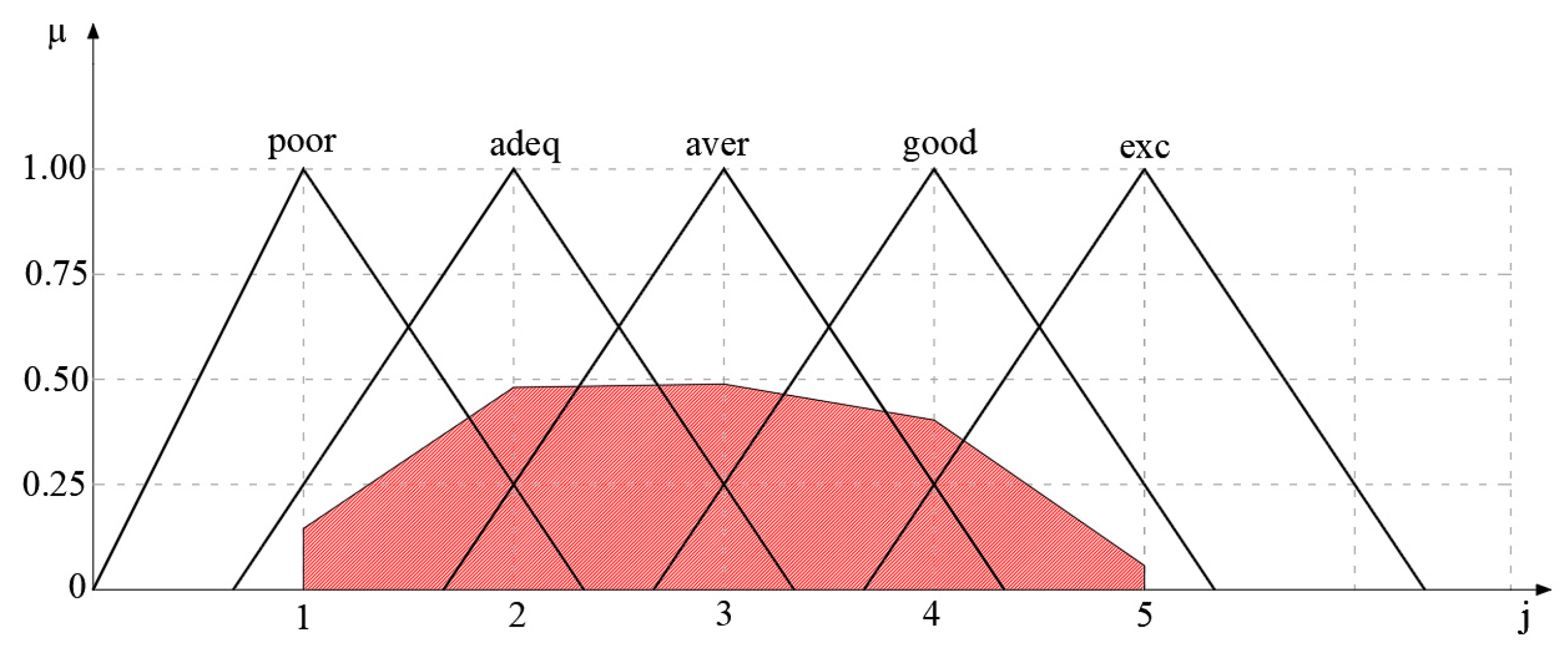
Figure 10.
Distribution of output values for indicator M maintainability for Crusher SB 1315 using max-min composition.
Figure 10.
Distribution of output values for indicator M maintainability for Crusher SB 1315 using max-min composition.
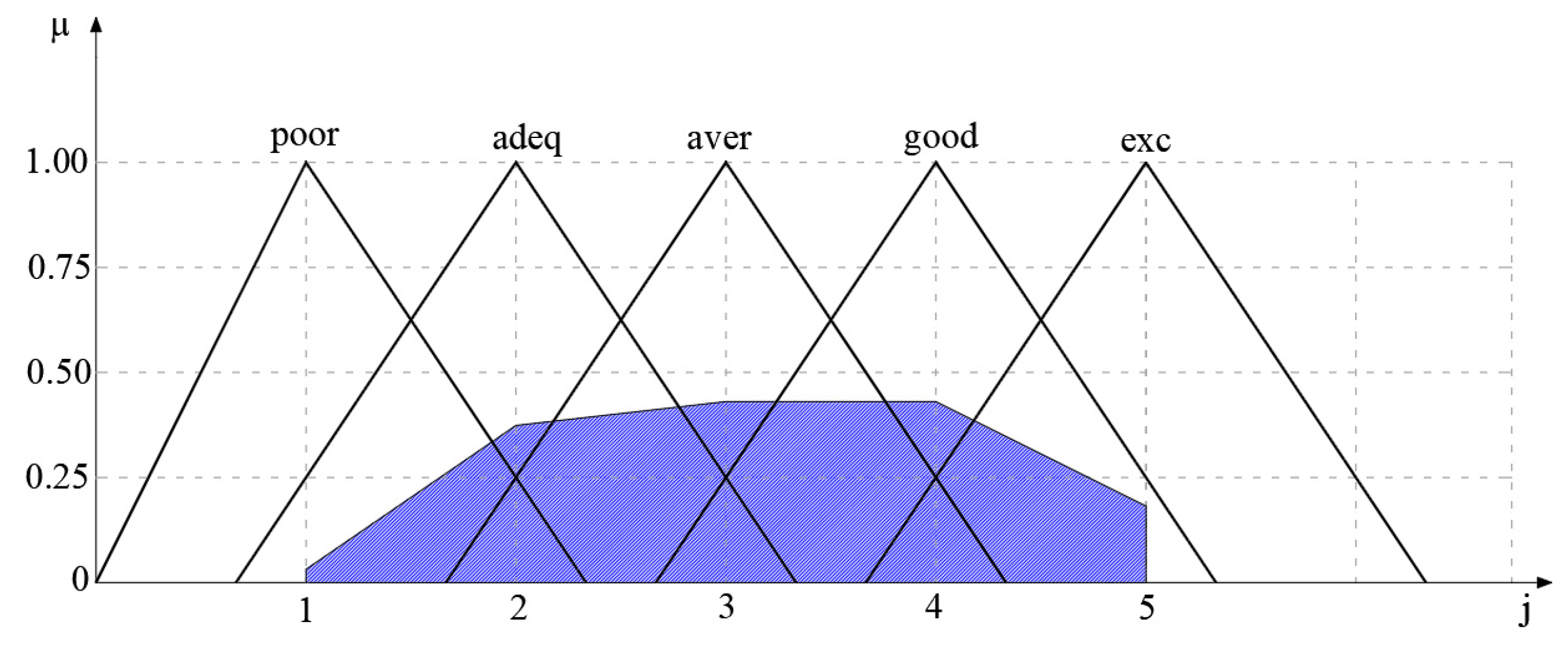
Figure 11.
Distribution of output values for indicator M maintainability for belt conveyors using max-min composition.
Figure 11.
Distribution of output values for indicator M maintainability for belt conveyors using max-min composition.
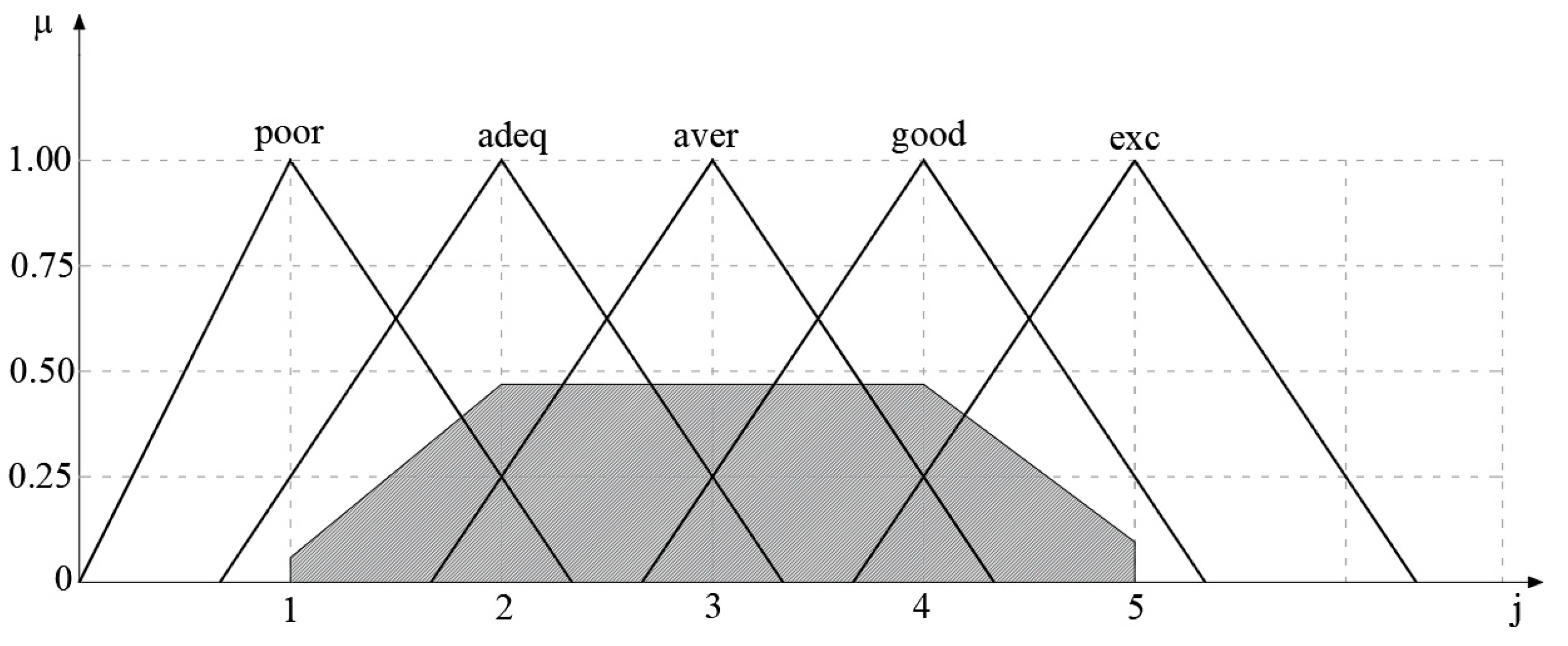
4.4. Determination of Partial Indicators of Reliability and Logistical Support of Parts of the Continuous Prats of Combined System - R and F
On the basis of the submitted results, the following estimates were obtained for each analyzed part of the continuous system when these two partial indicators are concerned.
Table 9.
Ratings of partial reliability and logistical support for Crusher SB 1515, Crusher SB 1315 and belt conveyors.
Table 9.
Ratings of partial reliability and logistical support for Crusher SB 1515, Crusher SB 1315 and belt conveyors.
| Crusher SB 1515 | Crusher SB 1315 | Belt conveyors | |||||||||||||
| poor | adeq | aver | good | exc | poor | adeq | aver | good | exc | poor | adeq | aver | good | exc | |
| R | 0.0700 | 0.6400 | 0.2400 | 0.0500 | 0.0000 | 0.2700 | 0.6200 | 0.1100 | 0.0000 | 0.0000 | 0.0700 | 0.6500 | 0.2400 | 0.0400 | 0.0000 |
| F | 0.0000 | 0.0000 | 0.4200 | 0.4850 | 0.0950 | 0.0000 | 0.2600 | 0.3700 | 0.3250 | 0.0450 | 0.0000 | 0.0000 | 0.4600 | 0.5000 | 0.0400 |
Using the estimated values for the partial indicators for system maintainability, the final ratings for the partial indicators R, M , and F for Crusher SB 1515, Crusher SB 1315 and belt conveyors in the fuzzy number form.
Table 10.
Corresponding fuzzy numbers for Crusher SB 1515, Crusher SB 1315 and belt conveyors.
| Crusher SB 1515 | Crusher SB 1315 | Belt conveyors | |||||||||||||
| poor | adeq | aver | good | exc | poor | adeq | aver | good | exc | poor | adeq | aver | good | exc | |
| R | 0.2300 | 0.7175 | 0.4125 | 0.1100 | 0.1250 | 0.4250 | 0.7150 | 0.2650 | 0.0275 | 0.0000 | 0.2325 | 0.7275 | 0.4125 | 0.1000 | 0.0100 |
| M | 0.1250 | 0.4845 | 0.4850 | 0.4163 | 0.0713 | 0.0250 | 0.3150 | 0.4575 | 0.4575 | 0.2275 | 0.0625 | 0.4650 | 0.4650 | 0.4650 | 0.0950 |
| F | 0.0000 | 0.1050 | 0.5413 | 0.6138 | 0.2163 | 0.0650 | 0.3525 | 0.5163 | 0.4288 | 0.1263 | 0.0000 | 0.1150 | 0.5850 | 0.6250 | 0.1650 |
Based on the obtained ratings in the form of fuzzy number, the ratings obtained using the max-min composition for the specified parts of the CCS system are shown in the following table.
Table 11.
Obtained ratings for operational safety using the max-min composition.
| D-dependability | poor | adeq | aver | good | exc |
| Crusher SB 1515 | 0.0713 | 0.4125 | 0.4850 | 0.4850 | 0.1050 |
| Crusher SB 1315 | 0.0275 | 0.2650 | 0.3033 | 0.3033 | 0.2478 |
| Belt conveyors | 0.0950 | 0.4125 | 0.4650 | 0.4650 | 0.6250 |
Figure 12.
Distribution of output values for D dependability for Crusher SB 1515 using max-min composition.
Figure 12.
Distribution of output values for D dependability for Crusher SB 1515 using max-min composition.
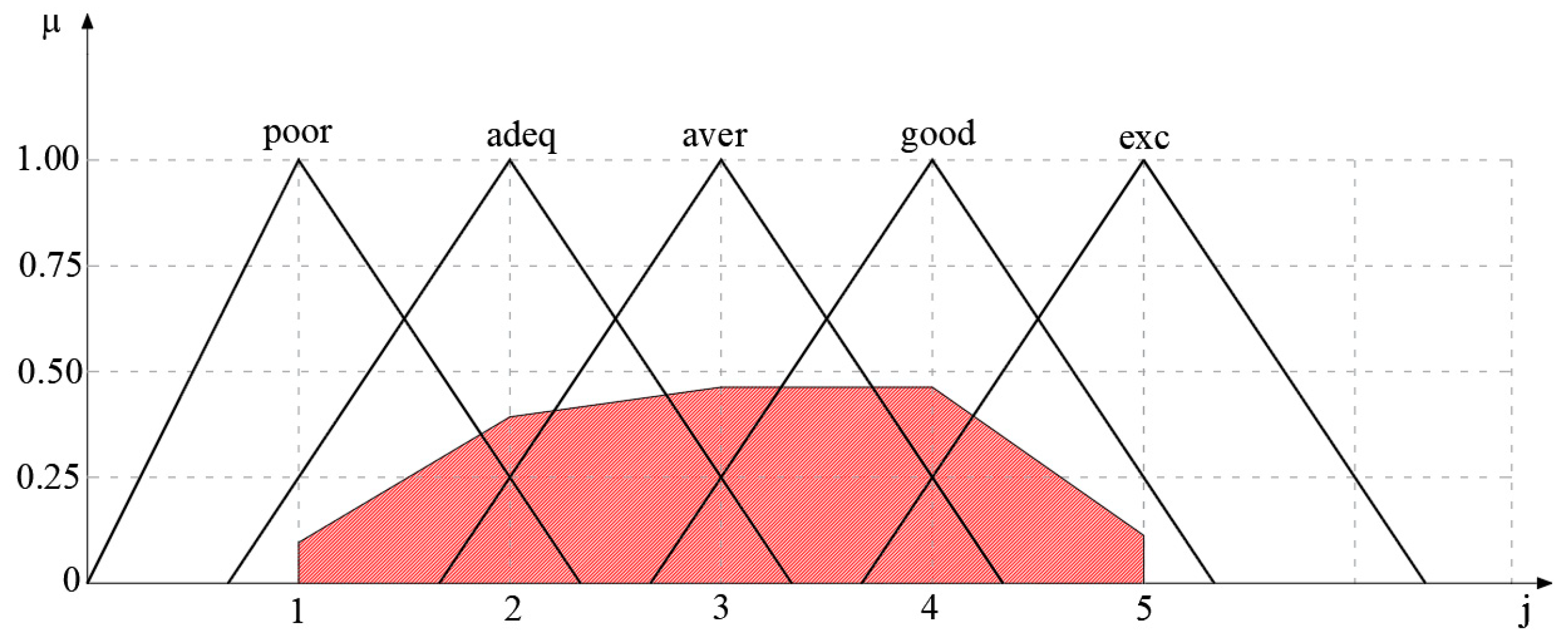
Figure 13.
Distribution of output values for D dependability for Crusher SB 1315 using max-min composition.
Figure 13.
Distribution of output values for D dependability for Crusher SB 1315 using max-min composition.
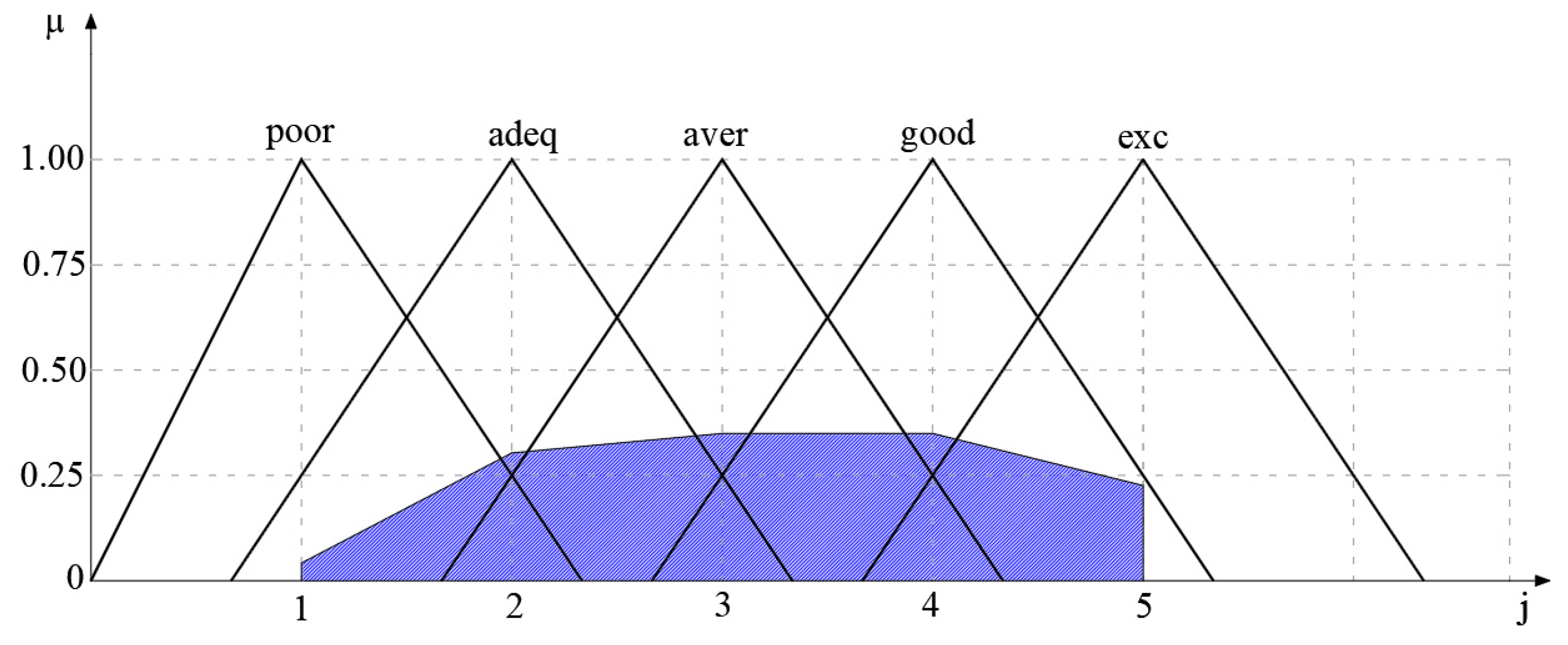
Figure 14.
Distribution of output values for D dependability for belt conveyors using max-min composition.
Figure 14.
Distribution of output values for D dependability for belt conveyors using max-min composition.
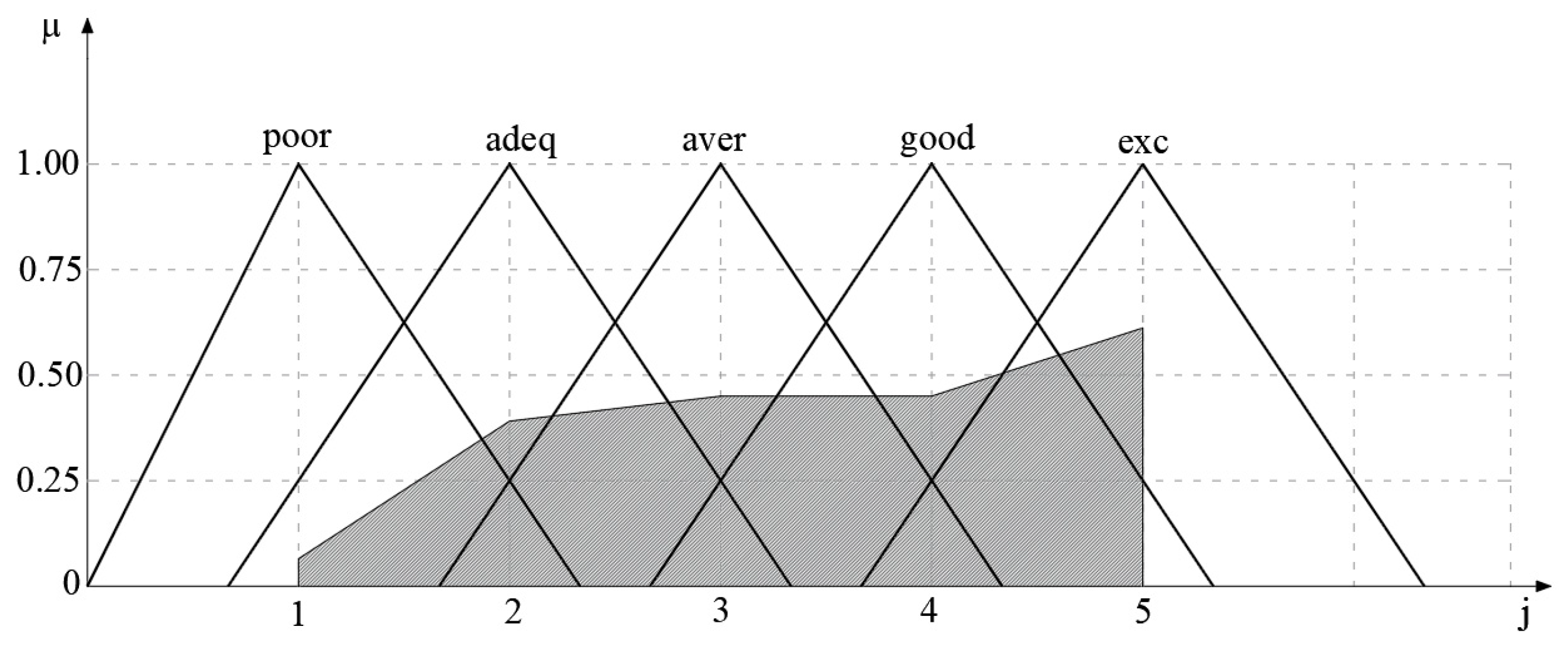
4.5. Dependability of the CCS System at the Open Pit Gacko
On the basis of obtained ratings for dependability of the system parts, the overall rating of dependability was obtained using the max-min composition and reads as follows:
(0.07125, 0.3033, 0.30333, 0.30333, 0.105).
Further analysis shows that the corresponding values obtained by the best fit method are equal to:
(1.02977, 0.78942, 0.71215, 0.77866, 0.99645).
The corresponding reciprocal values of the relative distances are:
(0.69156, 0.90211, 1, 0.91458, 0.71468),
while the values of normalized reciprocal values are equal to:
(0.16376, 0.21362, 0.23680, 0.21657, 0.16923).
Appropriate linguistic evaluation
On a scale of 1-5, the mentioned system in operation has a center of gravity of linguistic assessment for the max-min composition of 2.9860. Dependability is 59%.
Figure 15.
Distribution of output values for D dependability for CCS system using max-min composition.
Figure 15.
Distribution of output values for D dependability for CCS system using max-min composition.
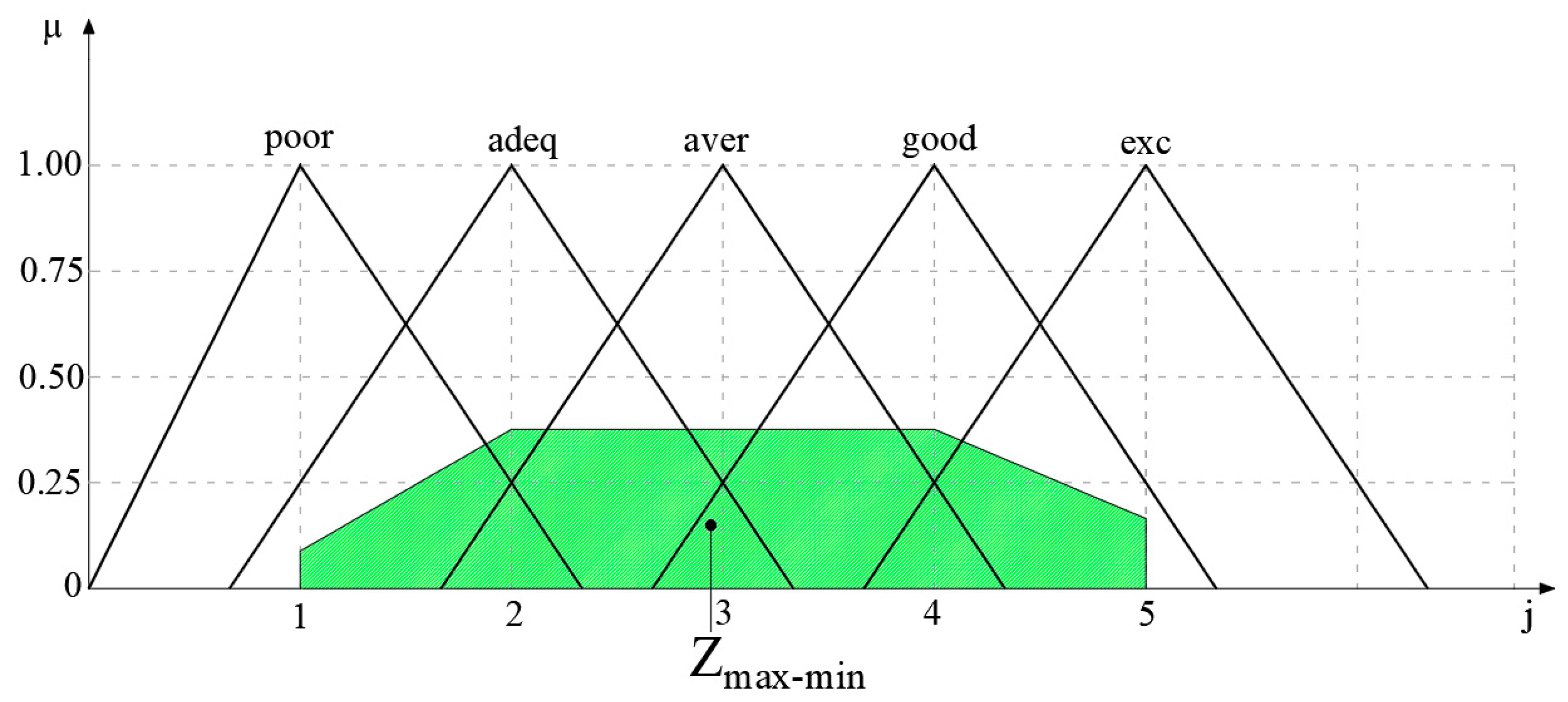
5. Verification of Fuzzy Model
The verification model is based on the results of systematic monitoring of the work of the continuous part of the combined system, which is carried out by a specially designated service within Gacko Mine and Thermal Power Plant. The effective system operating time represents the total operating time in the observed period and is calculated by subtracting the total downtime (failures) from the calendar fund. The operation of each system is accompanied by certain failures that have a direct impact on the utilization and reliability of the system. These failures can be planned or unplanned. Planned downtime refers to predefined technological operations and regular service maintenance. Unplanned failures are unpredictable and are not an integral part of the system's working hours. The department in charge of monitoring the operation of the analyzed system keeps records that include the beginning, duration, and type of failures. These records are maintained on a shift or daily basis, and an official monthly report is issued on the operation of the system as a whole, including the continuous part.
Failures are categorized into the following groups:
- technological failures,
- electrical failures,
- mechanical failures,
- shift of workers,
- equipment overhaul,
- daily review,
- weather conditions.
Figure 16.
The authors of the article with representatives of the Gacko mine during a tour of the field (private archive).
Figure 16.
The authors of the article with representatives of the Gacko mine during a tour of the field (private archive).
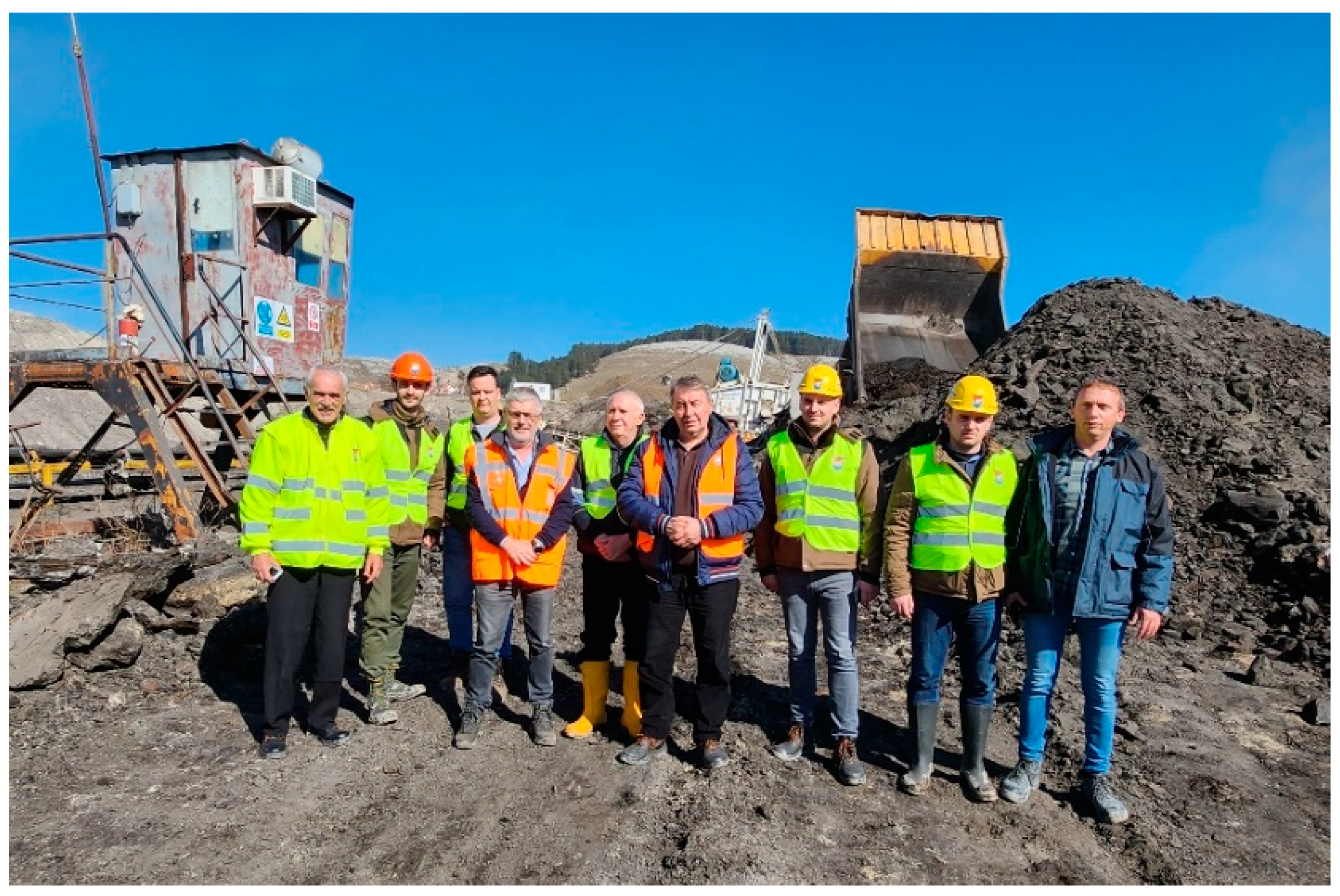
The following figure shows the percentage participation by types of failures for the CCS system by year.
Figure 17.
The percentage of failures of the CCS system in the period from 2018-2023. years.
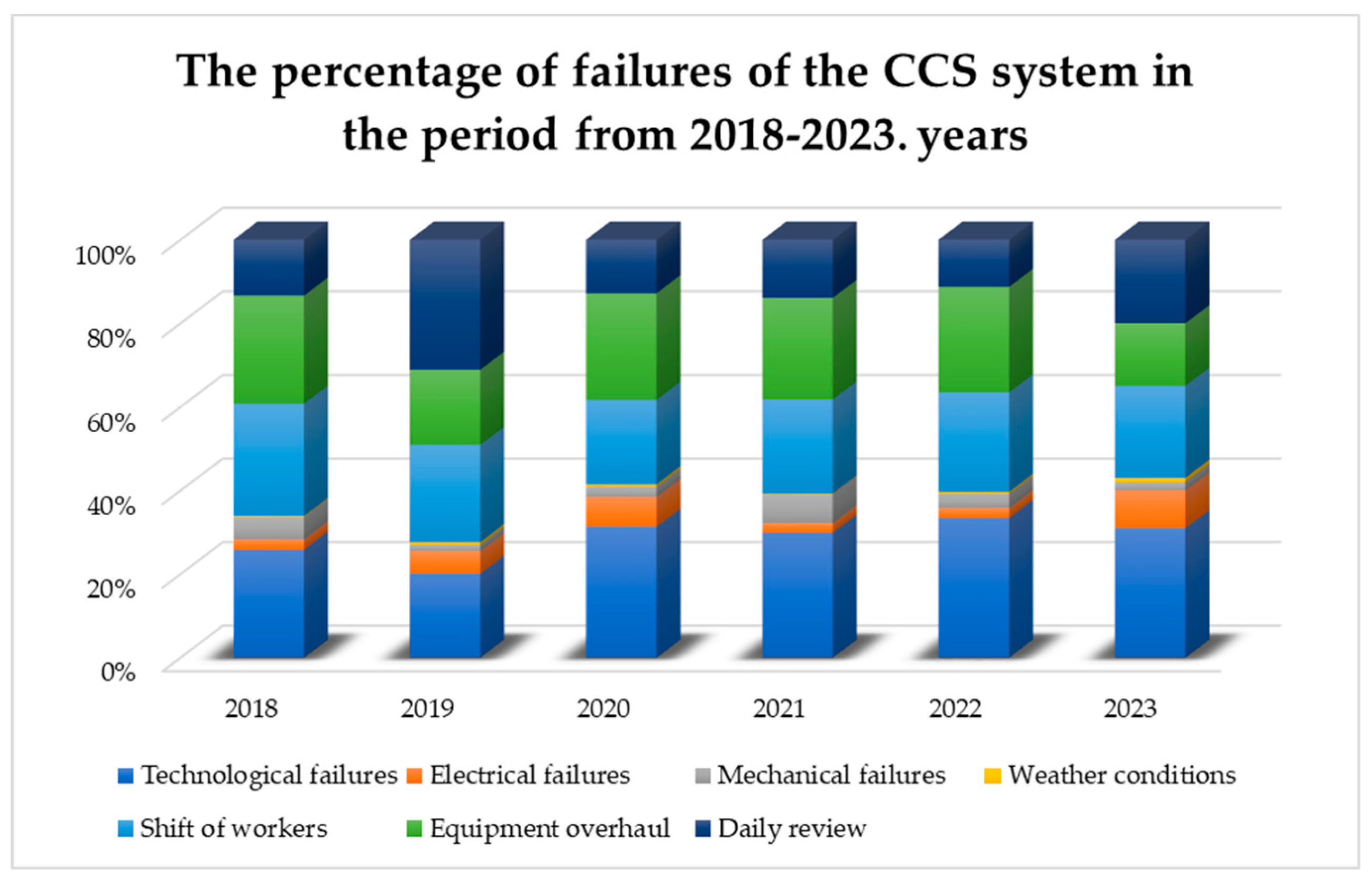
This graph shows the percentage participation of different types of failures in the operation of the CCS system in the period from 2018 to 2023. The key indicators of the graph are as follows:
- Technological failures are consistently high and varies from 20.1% to 33.4% per year, which accounts for the largest part of total downtime (29% for a period of 6 years).
- Shift of workers and equipment overhaul are also significant downtime factors with overall percentages of 23% and 22%.
- Electrical failures and mechanical failures have a relatively smaller share, but show variations between years.
- Weather conditions have the least participation in total downtime (0.5% for a period of 6 years).
- Daily review varies by year, but records a significant participation of 17% for the entire observed period.
Overall data show that technological failures, shift of workers and equipment overhaul are the most dominant factors in the operation of the CCS system, while weather conditions are the least significant.
Dependability of the CCS system in the period 2018-2023 is shown in the following figure (Figure 18).
Figure 18.
Dependability of the continuous part of the CCS system in the period from 2018-2023. years.
Figure 18.
Dependability of the continuous part of the CCS system in the period from 2018-2023. years.
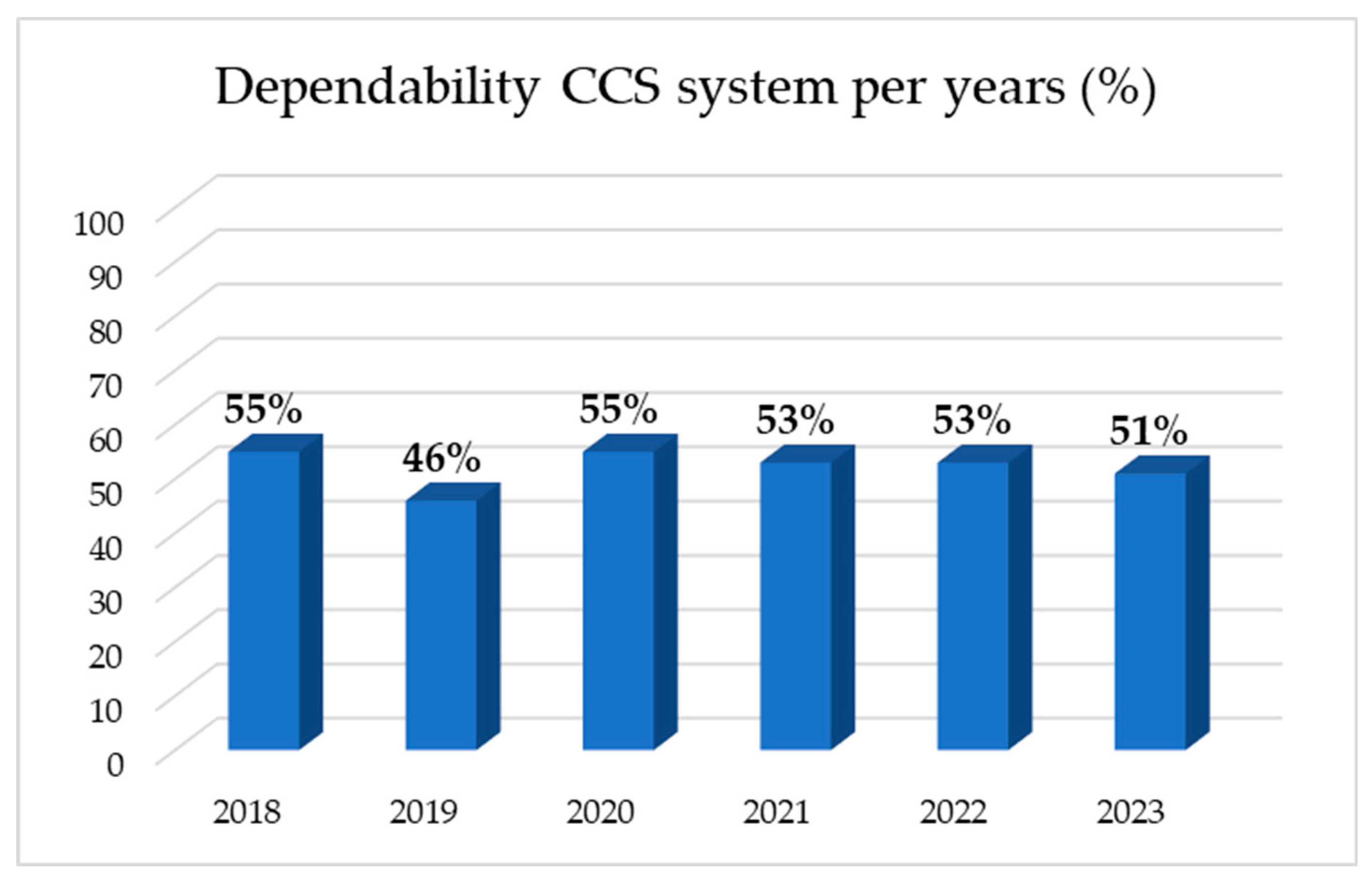
Data on the dependability of the CCS system in percentages for the period from 2018 to 2023 show slight variations. In 2018 and 2020, the system had the highest dependability of 55%. In 2019, dependability was the lowest, at 46%. This was the result of a significant percentage of failures related to the daily inspection of equipment, which was significantly higher in 2019 compared to all others years. In 2021 and 2022, dependability was stable at 53%, while 2023 saw a slight drop to 51%. Overall, system dependability varies between 46% and 55% over the observed period. The average value of dependability for the period of 6 years is 52.16%.
6. Conclusions
This paper presents a model for evaluating the dependability of technical systems using fuzzy logic. It breaks down dependability into different indicators and combines them using the max-min composition method.
Unlike conventional models that rely on IT monitoring systems, this approach incorporates expert assessments from individuals directly involved in machine operation and maintenance. Its simplicity and reliance on expert judgment make it easy to implement without extensive data collection.
This model offers a fast way to assess system safety and provides valuable insights for enhancing specific indicators and overall dependability. By following the model's recommendations, companies can streamline maintenance activities, analyze workflows, pinpoint weaknesses, and optimize the lifecycles of machinery to lower operational expenses.
Field experience confirms that the model accurately reflects the dependability of analyzed systems, considering factors such as system components, structure, age, working conditions, and organizational influences. When comparing the reliability data obtained through the fuzzy logic model with the actual field data collected over the period from 2018 to 2023, there is a strong correlation. The dependability obtained by the model is 59 %, and based on historical data for a period of 6 years, the average value of dependability is 52.6 %. This consistency underscores the model's effectiveness in capturing the real-world performance and dependability of the CCS systems.
Moreover, the historical data's alignment with the model's output validates the use of fuzzy logic in predicting and improving dependability. This approach not only facilitates proactive maintenance and risk management but also supports strategic decision-making by providing a sophisticated understanding of system vulnerabilities. The adaptability of the model to different mining contexts and its reliance on expert knowledge further enhance its practicality and robustness. Ultimately, this model serves as a valuable tool for mining companies aiming to achieve greater sustainability, efficiency, and cost-effectiveness in their operations.
Future research could explore further refinement of this model by integrating it with advanced data analytics and machine learning techniques to enhance predictive accuracy and adaptability. Additionally, expanding the application of this model to other industries beyond mining could reveal broader insights and benefits, establishing it as a versatile tool for dependability assessment across various sectors. The continued evolution and validation of this model will ensure its relevance and efficacy in the ever-changing landscape of technical system management.
Author Contributions
Conceptualization, N.S. and M.G.; methodology N.S., M.G. and P.M..; Writing –review and editing N.S.,P.M., D.K., A.D., and M.G., supervision S.S., N.S. and M.G. All authors have read and agreed to the published version of the manuscript.
Funding
This work was financially supported by the Ministry of Science, Technological Development and Innovation of the Republic of Serbia, Contract on realization and financing the scientific research work of the Mining and Metallurgy Institute Bor in 2024, Contract No.: 451-03-66/2024-03/ 200052.
Acknowledgments
Gratitude to Ministry of Science, Technological Development and Innovation of the Republic of Serbia. Mining and Metallurgy Institute Bor, Zeleni bulevar 35, Bor. Gacko Mine and Thermal Power Plant
Conflicts of Interest
The authors declare no conflict of interest.
References
- Ali, S., Giurco, D., Arndt, N. et al. Mineral supply for sustainable development requires resource governance. Nature 543, 367–372 (2017). [CrossRef]
- Dubiński, J. (2013). Sustainable Development of Mining Mineral Resources. Journal of Sustainable Mining, 12(1), 1–6. [CrossRef]
- Purhamadani, E., Bagherpour, R., & Tudeshki, H. (2020). Energy consumption in open-pit mining operations relying on reduced energy consumption for haulage using in-pit crusher systems. Journal of Cleaner Production, 125228. [CrossRef]
- Zhang, S., & Xia, X. (2011). Modeling and energy efficiency optimization of belt conveyors. Applied Energy, 88(9), 3061–3071. [CrossRef]
- Tabelin, C. B., Dallas, J., Casanova, S., Pelech, T., Bournival, G., Saydam, S., & Canbulat, I. (2021). Towards a low-carbon society: A review of lithium resource availability, challenges and innovations in mining, extraction and recycling, and future perspectives. Minerals Engineering, 163, 106743. [CrossRef]
- Ercelebi, S.G.; Bascetin, A. Optimization of shovel-truck system for surface mining. J. South. Afr. Inst. Min. Metall. 2009, 109, 433–439.
- Bao, H.; Knights, P.; Kizil, M.; Nehring, M. Electrification Alternatives for Open Pit Mine Haulage. Mining 2023, 3, 1–25.
- Mohamad Issa & Adrian Ilinca & Daniel R. Rousse & Loïc Boulon & Philippe Groleau, 2023. "Renewable Energy and Decarbonization in the Canadian Mining Industry: Opportunities and Challenges," Energies, MDPI, vol. 16(19), pages 1-22, October.
- Kim, H.; Lee, W.-H.; Lee, C.-H.; Kim, S.-M. Development of Monitoring Technology for Mine Haulage Road through Sensor-Connected Digital Device and Smartphone Application. Appl. Sci. 2022, 12, 12166.
- Dejan V. Petrović, Miloš Tanasijević, Saša Stojadinović, Jelena Ivaz, Pavle Stojković. "Fuzzy Model for Risk Assessment of Machinery Failures" in Symmetry, MDPI AG (2020). [CrossRef]
- Gomilanovic, M.; Tanasijevic, M.; Stepanovic, S. Determining the Availability of Continuous Systems at Open Pits Applying Fuzzy Logic. Energies 2022, 15, 6786. [CrossRef]
- Djenadic, S.; Ignjatovic, D.; Tanasijevic, M.; Bugaric, U.; Jankovic, I.; Subaranovic, T. Development of the Availability Concept by Using Fuzzy Theory with AHP Correction, a Case Study: Bulldozers in the Open-Pit Lignite Mine. Energies 2019, 12, 4044. [CrossRef]
- Gomilanovic, M.; Bugaric, U.; Bankovic, M.; Stanic, N.; Stepanovic, S. Determining the Availability of Continuous Systems in Open Pits Using ANFIS and a Simulation Model. Energies 2024, 17, 1138. [CrossRef]
- Gomilanovic, M.; Tanasijevic, M.; Stepanovic, S.; Miletic, F. A Model for Determining Fuzzy Evaluations of Partial Indicators of Availability for High-Capacity Continuous Systems at Coal Open Pits Using a Neuro-Fuzzy Inference System. Energies 2023, 16, 2958. [CrossRef]
- Čelebić, M.; Bajić, D.; Bajić, S.; Banković, M.; Torbica, D.; Milošević, A.; Stevanović, D. Development of an Integrated Model for Open-Pit-Mine Discontinuous Haulage System Optimization. Sustainability 2024, 16, 3156. [CrossRef]
- Urošević, K.; Gligorić, Z.; Miljanović, I.; Beljić, Č.; Gligorić, M. Novel Methods in Multiple Criteria Decision-Making Process (MCRAT and RAPS)—Application in the Mining Industry. Mathematics 2021, 9, 1980. [CrossRef]
- Halilović, D.; Gligorić, M.; Gligorić, Z.; Pamučar, D. An Underground Mine Ore Pass System Optimization via Fuzzy 0–1 Linear Programming with Novel Torricelli–Simpson Ranking Function. Mathematics 2023, 11, 2914. [CrossRef]
- Li, S.; Huang, Q.; Hu, B.; Pan, J.; Chen, J.; Yang, J.; Zhou, X.; Wang, X.; Yu, H. Mining Method Optimization of Difficult-to-Mine Complicated Orebody Using Pythagorean Fuzzy Sets and TOPSIS Method. Sustainability 2023, 15, 3692. [CrossRef]
- Bajić, S.; Bajić, D.; Gluščević, B.; Ristić Vakanjac, V. Application of Fuzzy Analytic Hierarchy Process to Underground Mining Method Selection. Symmetry 2020, 12, 192. [CrossRef]
- Jaderi, F., Ibrahim, Z. Z., & Zahiri, M. R. (2018). Criticality Analysis of Petrochemical Assets using Risk Based Maintenance and the Fuzzy Inference System. Process Safety and Environmental Protection. [CrossRef]
- Bakhtavar, E., Hosseini, S., Hewage, K. et al. Air Pollution Risk Assessment Using a Hybrid Fuzzy Intelligent Probability-Based Approach: Mine Blasting Dust Impacts. Nat Resour Res 30, 2607–2627 (2021). [CrossRef]
- Tubis, A.; Werbińska-Wojciechowska, S.; Wroblewski, A. Risk Assessment Methods in Mining Industry—A Systematic Review. Appl. Sci. 2020, 10, 5172. [CrossRef]
- Jiskani, I. M., Cai, Q., Zhou, W., & Lu, X. (2020). Assessment of risks impeding sustainable mining in Pakistan using fuzzy synthetic evaluation. Resources Policy, 69, 101820. [CrossRef]
- Spanidis, P.-M.; Roumpos, C.; Pavloudakis, F. A Fuzzy-AHP Methodology for Planning the Risk Management of Natural Hazards in Surface Mining Projects. Sustainability 2021, 13, 2369. [CrossRef]
- Djenadic, S.; Tanasijevic, M.; Jovancic, P.; Ignjatovic, D.; Petrovic, D.; Bugaric, U. Risk Evaluation: Brief Review and Innovation Model Based on Fuzzy Logic and MCDM. Mathematics 2022, 10, 811. [CrossRef]
- Dimitrijević, B.; Šubaranović, T.; Stević, Ž.; Kchaou, M.; Alqurashi, F.; Subotić, M. A Novel Hybrid Fuzzy Multiple-Criteria Decision-Making Model for the Selection of the Most Suitable Land Reclamation Variant at Open-Pit Coal Mines. Sustainability 2024, 16, 4424. [CrossRef]
- Ebrahimabadi, A., Pouresmaieli, M., Afradi, A., Pouresmaeili, E., & Nouri, S. (2018). Comparing Two Methods of PROMETHEE and Fuzzy TOPSIS in Selecting the Best Plant Species for the Reclamation of Sarcheshmeh Copper Mine. Asian Journal of Water, Environment and Pollution, 15(2), 141–152. [CrossRef]
- Liang, W.; Dai, B.; Zhao, G.; Wu, H. Assessing the Performance of Green Mines via a Hesitant Fuzzy ORESTE–QUALIFLEX Method. Mathematics 2019, 7, 788. [CrossRef]
- Nehring, M., Knights, P. F., Kizil, M. S., & Hay, E. (2018). A comparison of strategic mine planning approaches for in-pit crushing and conveying, and truck/shovel systems. International Journal of Mining Science and Technology, 28(2), 205–214. [CrossRef]
- Zhang, S., & Xia, X. (2011). Modeling and energy efficiency optimization of belt conveyors. Applied Energy, 88(9), 3061–3071. [CrossRef]
- Jankovic, I., (2020). Optimisation of the life cycle concept of auxiliary machinery at lignite open-pit mines, doctoral dissertation, Faculty of Mining and Geology, University of Belgrade.
- Todorovic, J., (1993). Technical Systems Maintenance Engineering, Yugoslav Society for Engines and Vehicles, Belgrade.
- Tanaskovic, T., (2001). Maintenance of mining machines, Faculty of Mining and Geology, University of Belgrade, Belgrade.
- Tanasijevic, M., (2007). Dependability of the mechanical components of bucket wheel, doctoral dissertation, Faculty of Mining and Geology, University of Belgrade.
- Krunic, D.J., (2021) Development of quality of service model for auxiliary equipment in open pit lignite mines, doctoral dissertation, Faculty of Mining and Geology, University of Belgrade.
- Krunić, D.J., Vujić, S., Tanasijević, M. et al. Model Approaches to Life Cycle Assessment of Auxiliary Machines Based on an Example of a Coal Mine in Serbia. J Min Sci 54, 404–413 (2018). [CrossRef]
- International Electrotechnical Vocabulary, Dependability and Quality of Service, IEC Standard, 1990, no. 50 (191).
- Jovancic P. (2014) Maintenance of Mining Machines, Faculty of Mining and Geology, University of Belgrade, Belgrade, 2014, ISBN: 978-86-7352-250-0.
- Wang, J.; Yang, J.B.; Sen, P. Safety Analyses and Synthesis Using Fuzzy Sets and Evidential Reasoning. Reliab. Eng. Syst. Saf. 1995, 47, 103–118.
Figure 1.
Gacko open pit (photographed by the author of the article: N.S.).
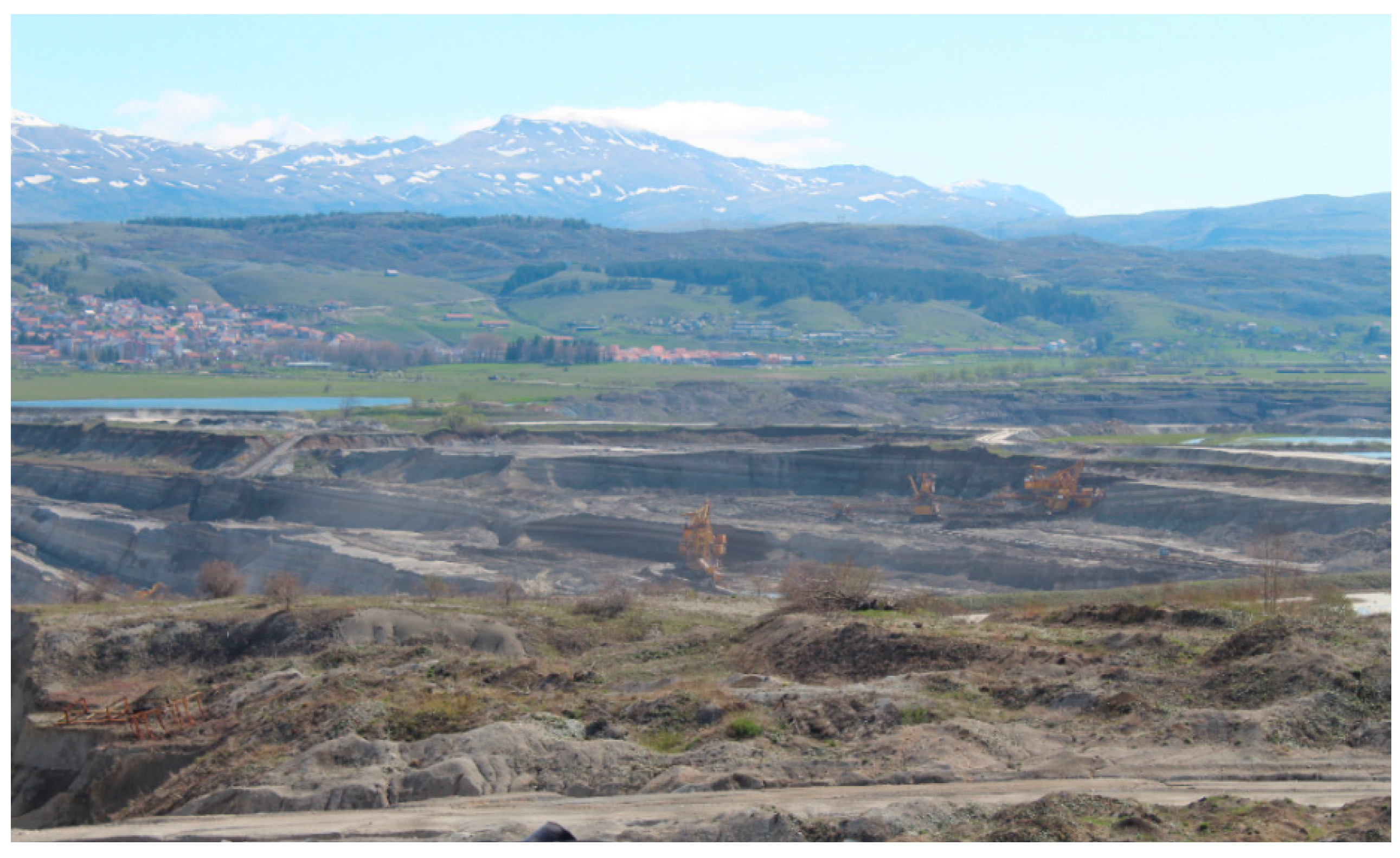
Figure 2.
View of the CCS system (Source Google Earth).
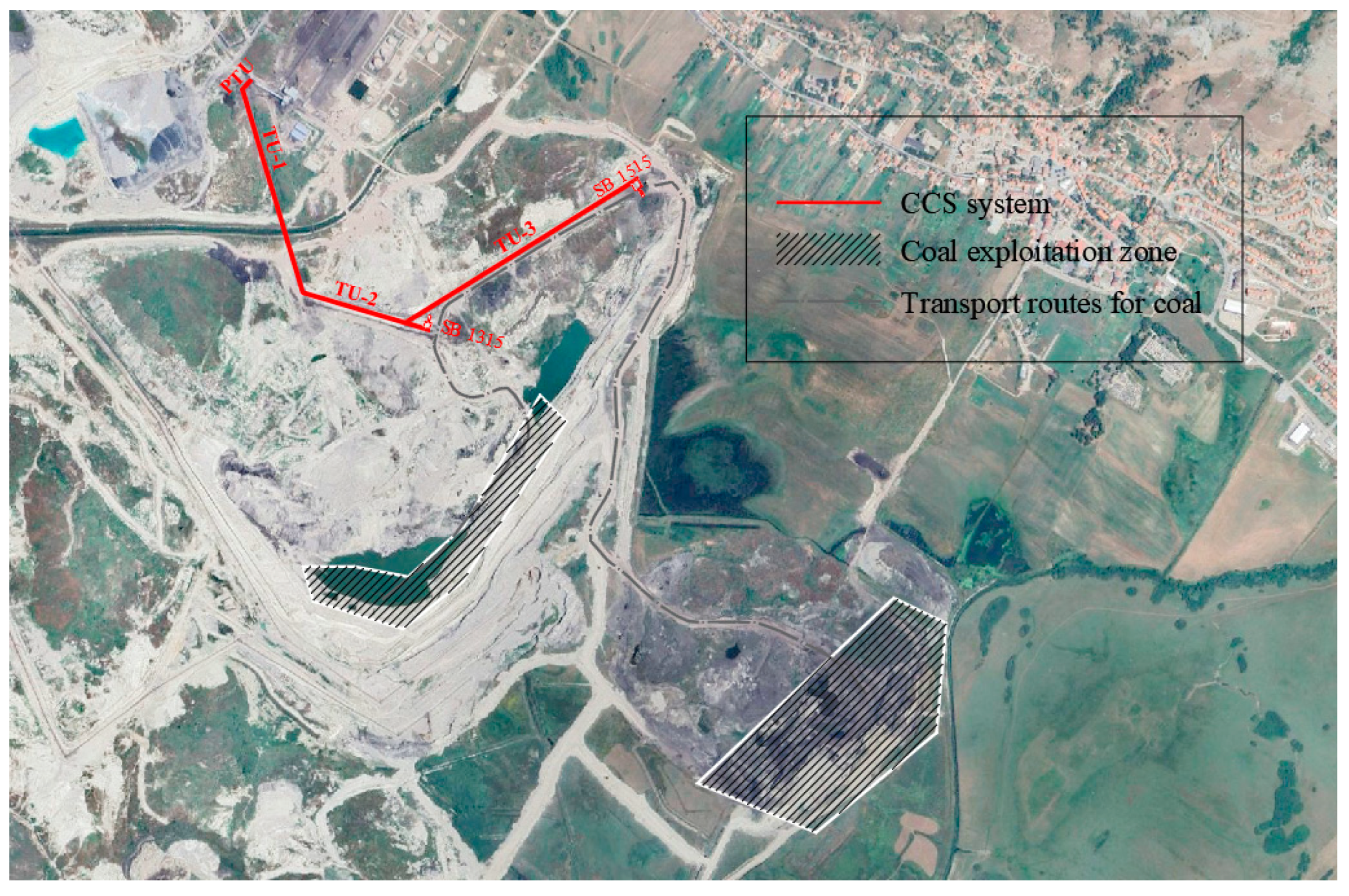
Figure 3.
Parts of CCS system at the open pit Gacko (private archive).
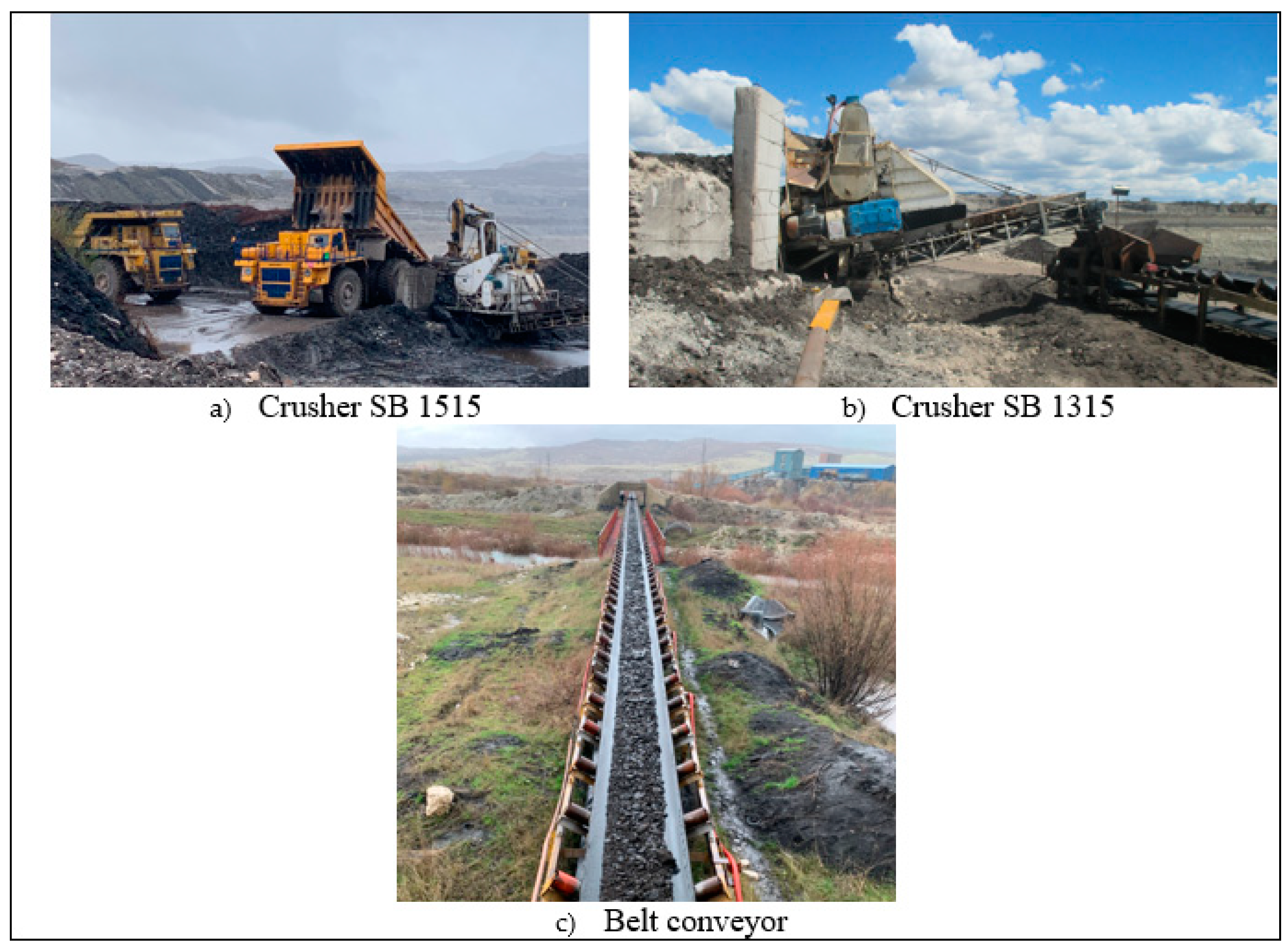
Figure 6.
Fuzzy sets.
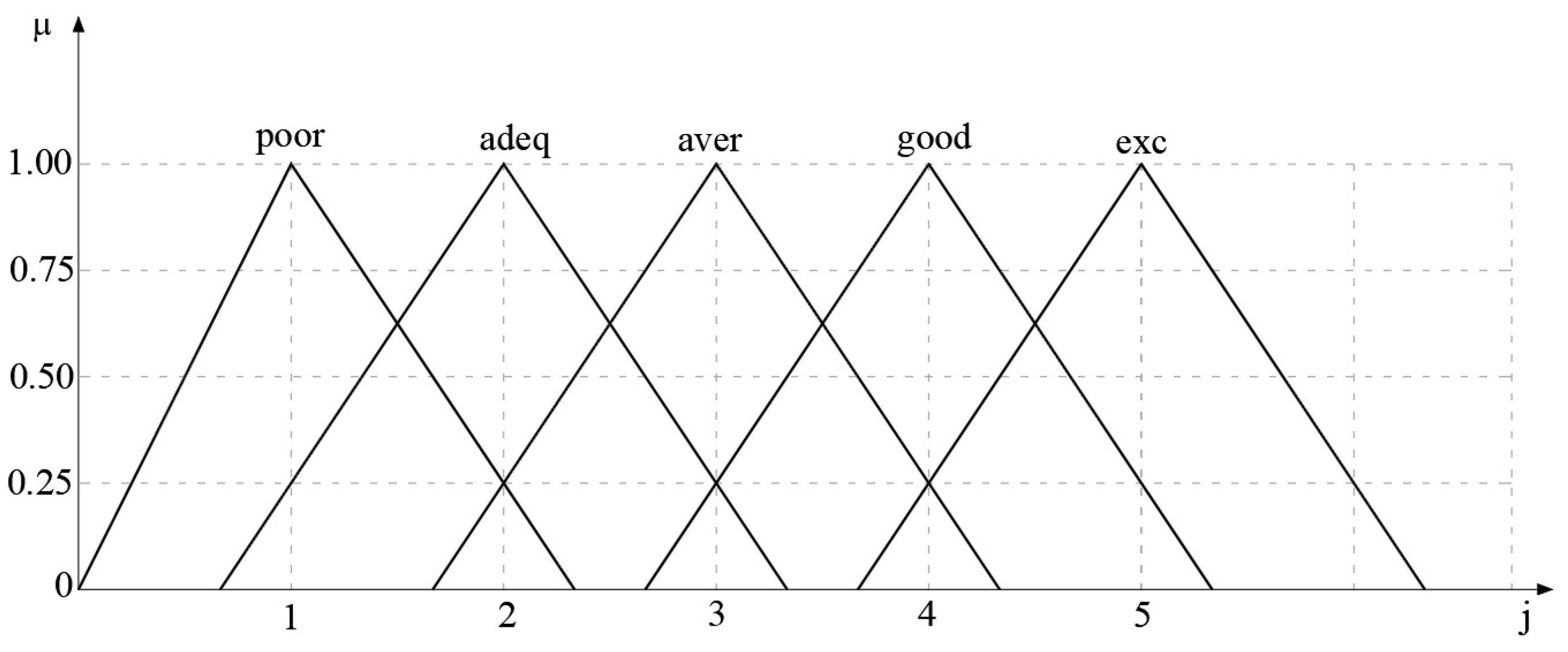
Figure 7.
Algorithm of fuzzy model for evaluation the dependability [11].
Figure 7.
Algorithm of fuzzy model for evaluation the dependability [11].
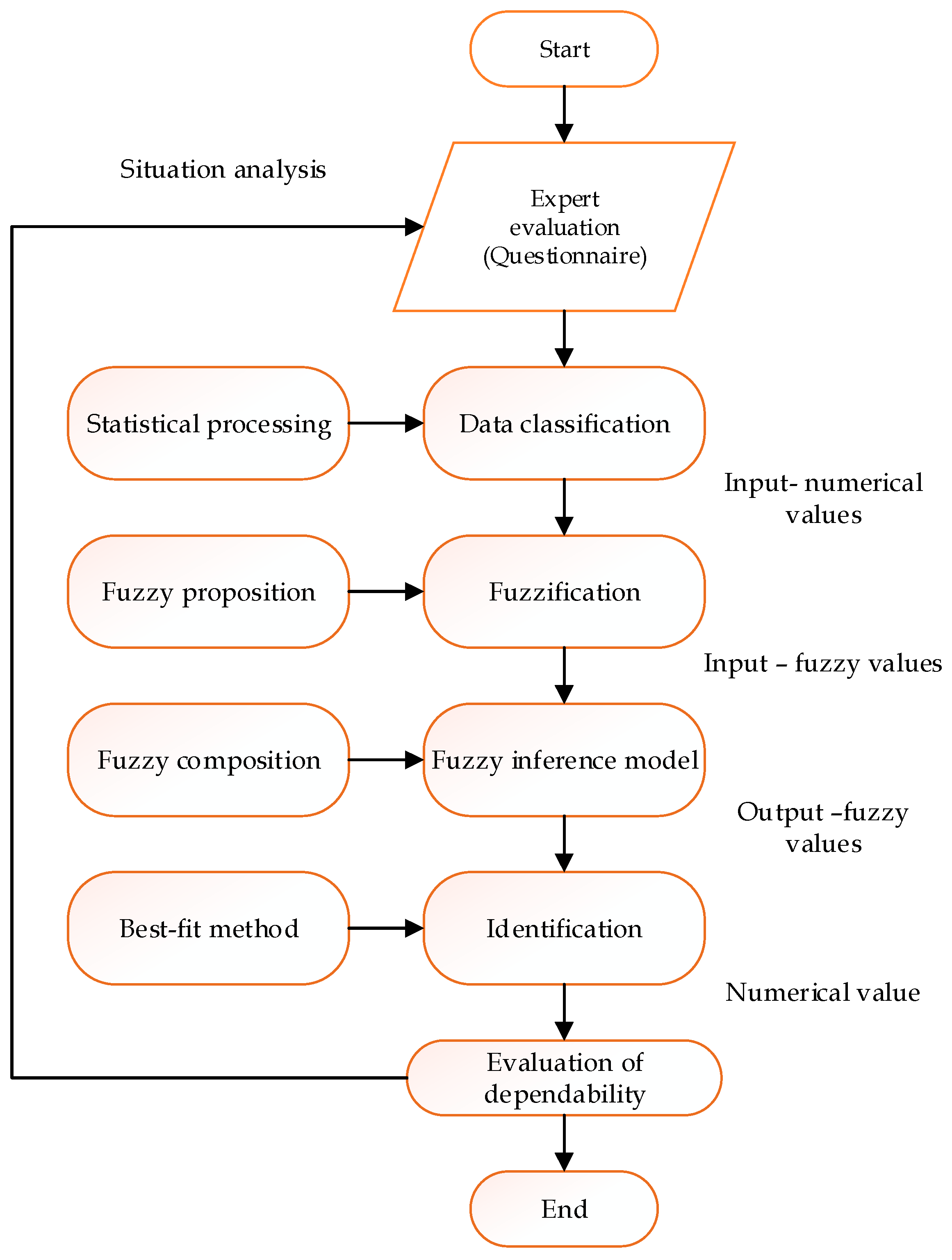
Figure 8.
Layout of questionnaire.
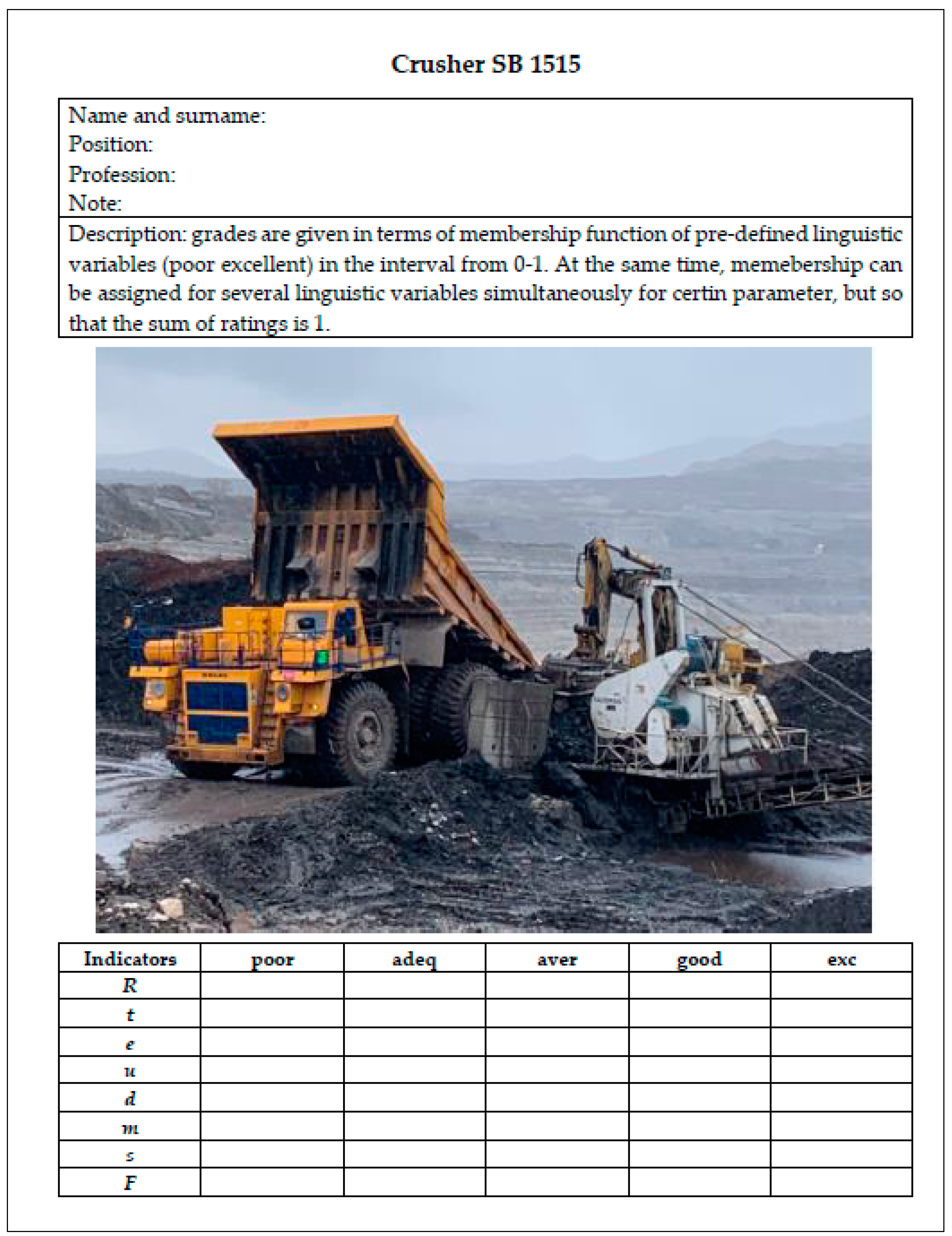
Disclaimer/Publisher’s Note: The statements, opinions and data contained in all publications are solely those of the individual author(s) and contributor(s) and not of MDPI and/or the editor(s). MDPI and/or the editor(s) disclaim responsibility for any injury to people or property resulting from any ideas, methods, instructions or products referred to in the content. |
© 2024 by the authors. Licensee MDPI, Basel, Switzerland. This article is an open access article distributed under the terms and conditions of the Creative Commons Attribution (CC BY) license (http://creativecommons.org/licenses/by/4.0/).
Copyright: This open access article is published under a Creative Commons CC BY 4.0 license, which permit the free download, distribution, and reuse, provided that the author and preprint are cited in any reuse.
Alerts
MDPI Initiatives
Important Links
© 2025 MDPI (Basel, Switzerland) unless otherwise stated









